| Abell 36 Out in the constellation of Virgo (the Virgin) is this cool looking planetary nebula. The gas that we can see is what's left of the central star's atmosphere once it went nova. The bright star in the center is now a white dwarf. It is thought that this nebula was formed about 10,000 years ago. It is about 780 light-years away. Image processed by Ron Yelton, original data from Telescope Live |
BBWo 56 This is an emission nebula - meaning that the gases are heated by the radiation from a nearby star just off to the left to the the point that it begins to glow. This image was taken using regular, visible light filters (RGB), as well as a hydrogen filter. This molecular cloud is almost exclusively made up of hydrogen which gives it the deep red color. This object is in the constellation Vela (the sails of a ship - the Argo). Image processed by Ron Yelton, original data from Telescope Live |
Collonder 399 - Brocchi's Cluster
This image was originally taken to photograph the group of stars in the center, upper-right. There are ten stars that form an asterism known as The Coathanger. I'm including it here in the nebula section because of the gas and dust that lies behind the stars. The cluster is just a happy coincidence. It sits in the constellation Vulpecula. Image processed by Ron Yelton, original data from Telescope Live |
|
Location: El
Sauce Observatory, Chile Date: July 2022 Mount: Mathis MI-1000 Telescope: Planewave CDK24 f/6.6 (CHI-1) (CCD) Camera: FLI PL9000 @ -25c Exposure: 73 x 3 min each for LRGB Total: 3 hr 30 min. |
Location: Heaven's
Mirror Observatory, Australia
Date: November 2024 Mount: Paramount MX+ Telescope: FSQ-106ED (AUS-2) Camera: QHY600m @ -25c Exposure:162 x 5 min each for HRGB Total: 13 hrs |
Location:
Heaven's Mirror Observatory,
Australia
Date: April 2023 Mount: Paramount MX+ Telescope: FSQ-106ED (AUS-2) Camera: QHY600m @ -25c (CMOS) Exposure: 74 x 5 min each for LRGB Total: 6 hrs 10 min |
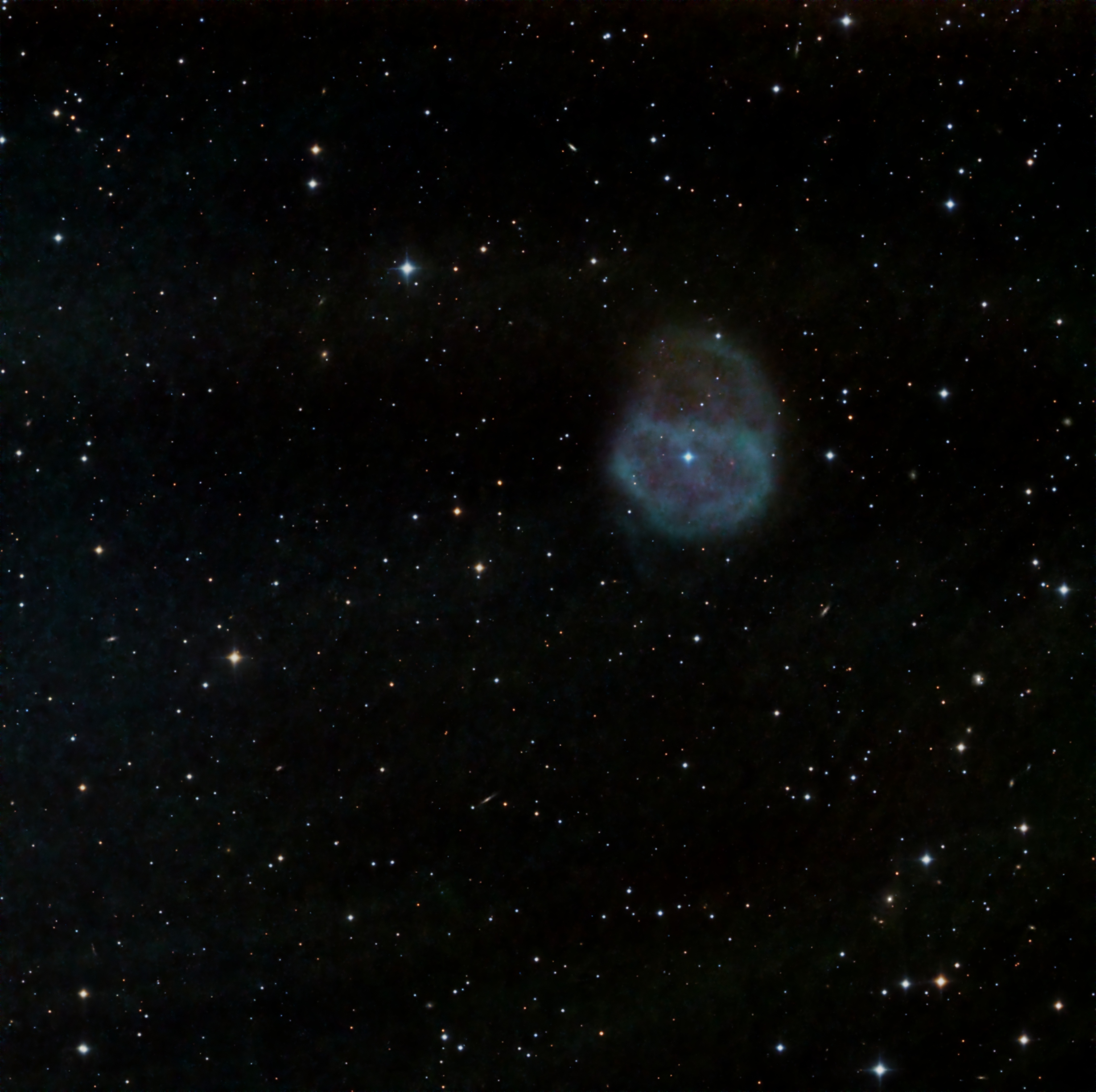 |
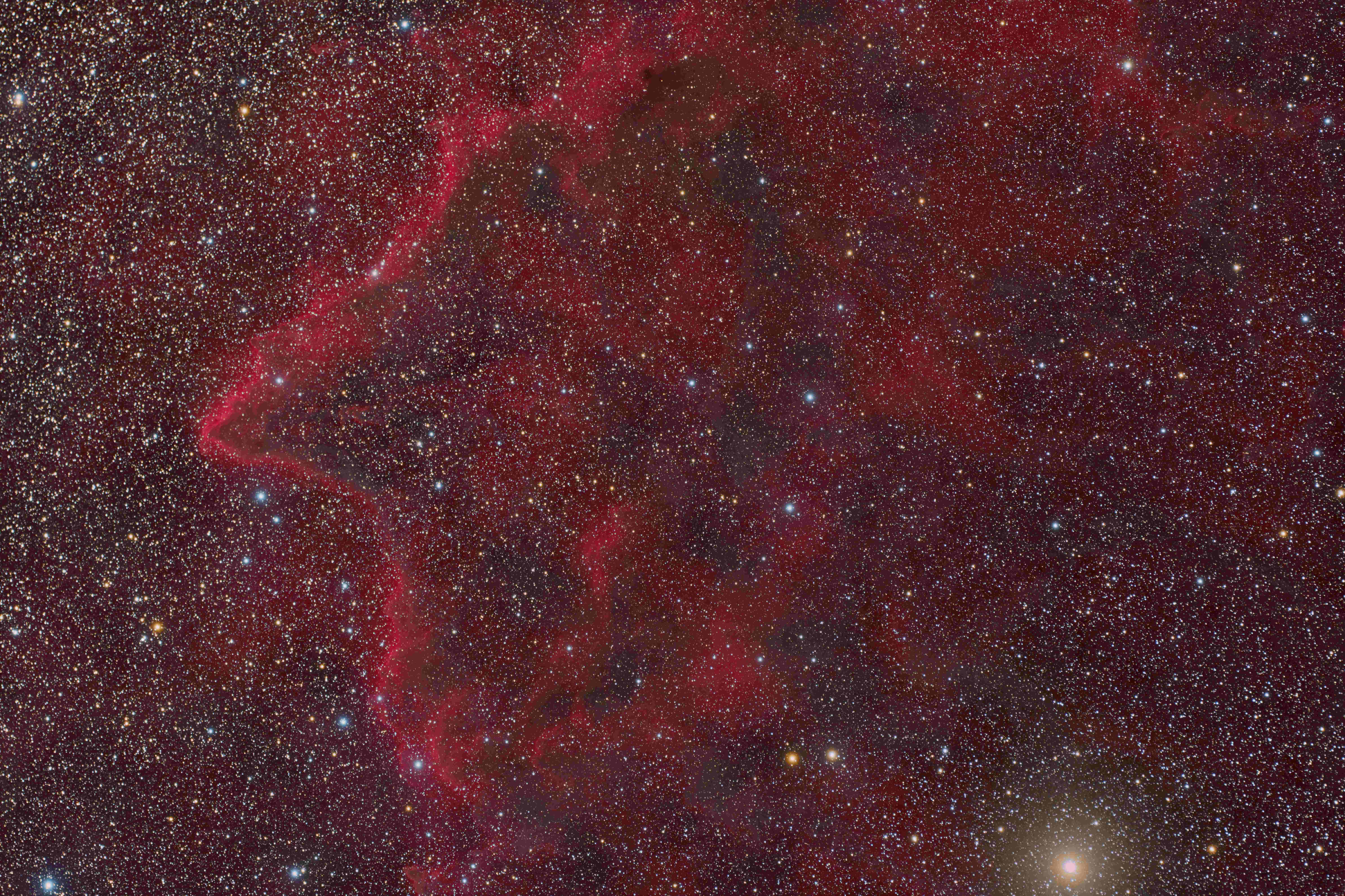 |
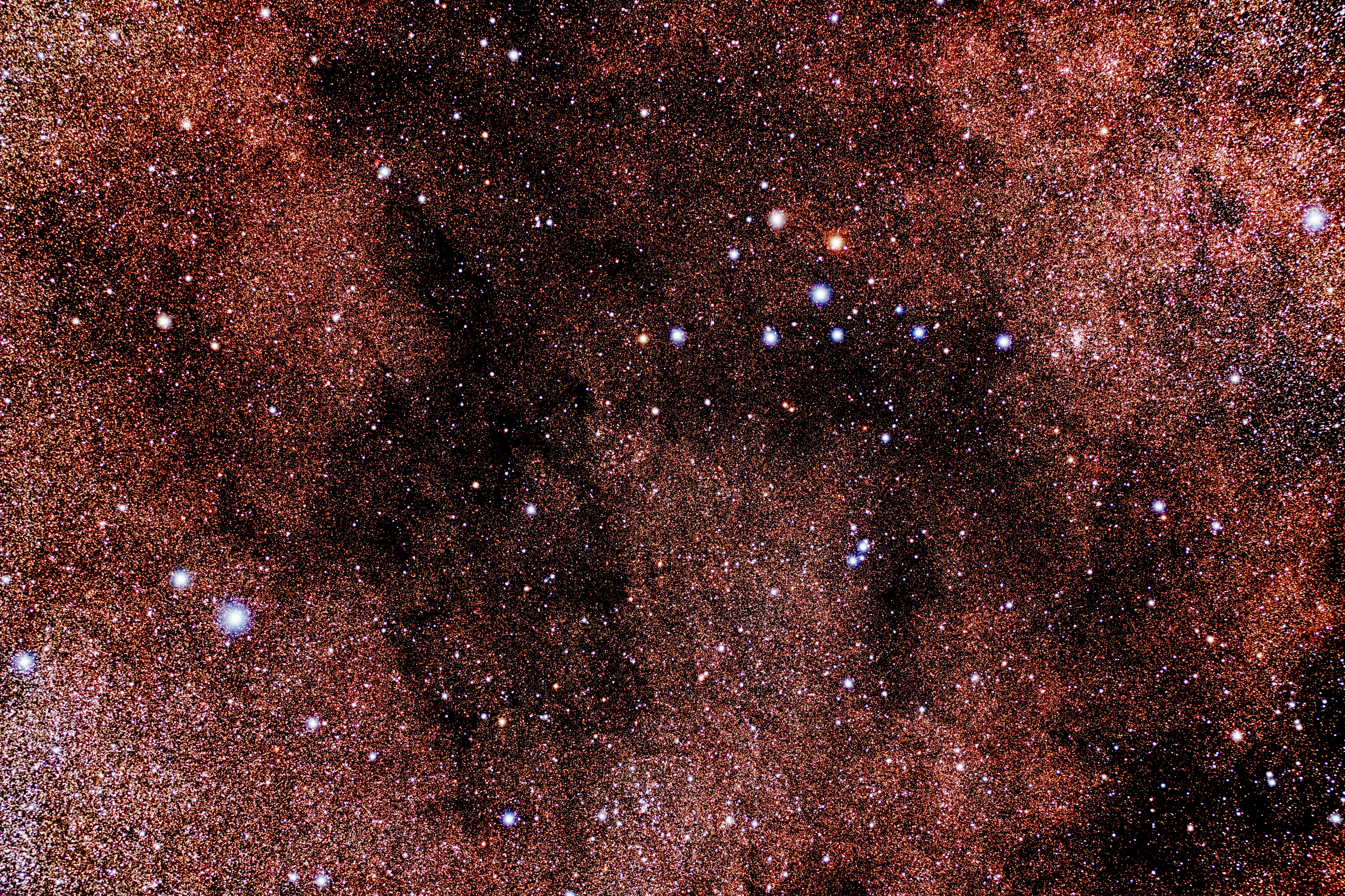 |
| NGC 3372 - The Carina Nebula This nebula, which resides in the constellation Carina about 8500 light-years away. It's one of the largest diffuse nebulae that we can see from Earth. It is four times as large and brighter than the famous Orion Nebula. It was discovered by Nicolas Louis de Lacaille in 1752 at the Cape of Good Hope. It is also one of the first five object that was photographed by the James Webb Space Telescope. Image processed by Ron Yelton, original data from Telescope Live |
Carina
Nebula - Panel 2 Wide-Field
This is a wide-field view of the region around the nebula to the left. Both images were taken using the HSO palette. Image processed by Ron Yelton, original data from Telescope Live |
CED 116 A diffuse nebula in the constellation Centaurus. It also looks to be an emission and reflection nebula as well based on the eroding edges and the illuminated central region. Image processed by Ron Yelton, original data from Telescope Live |
|
Location:
Heaven's Mirror Observatory,
Australia
Date: december 2024 Mount: Paramount MX+ Telescope: FSQ-106ED (AUS-2) Camera: QHY600m @ -25c Exposure: 97 x 5 min each for HSO Total: 7 hrs 35 min |
Location: El Sauce
Observatory, Chile
Date: July 2023 Mount: Mathis MI-1000/1250 Telescope: Planewave CDK24 (CHI-1) (CMOS) Camera: QHY600m @-25c Exposure: 58 x 5 min for HSO Total: 4 hrs 50 min |
Location: El Sauce
Observatory, Chile
Date: April 2023 Mount: Mathis MI-1000/1250 Telescope: Planewave CDK24 (CHI-1) (CMOS) Camera: QHY600m @-25c Exposure: 68 x 5 min for SHO Total: 5 hrs 40 min |
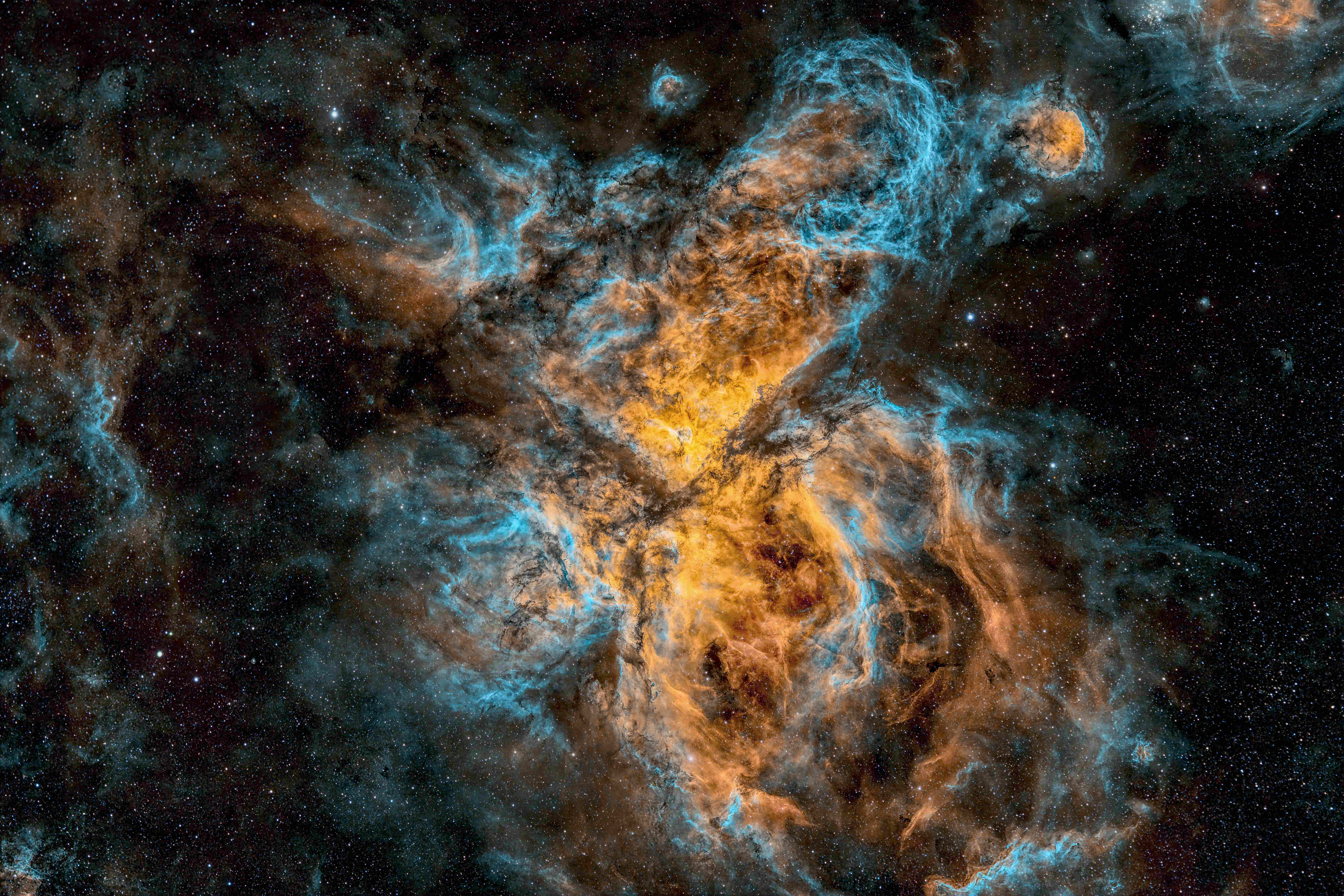 |
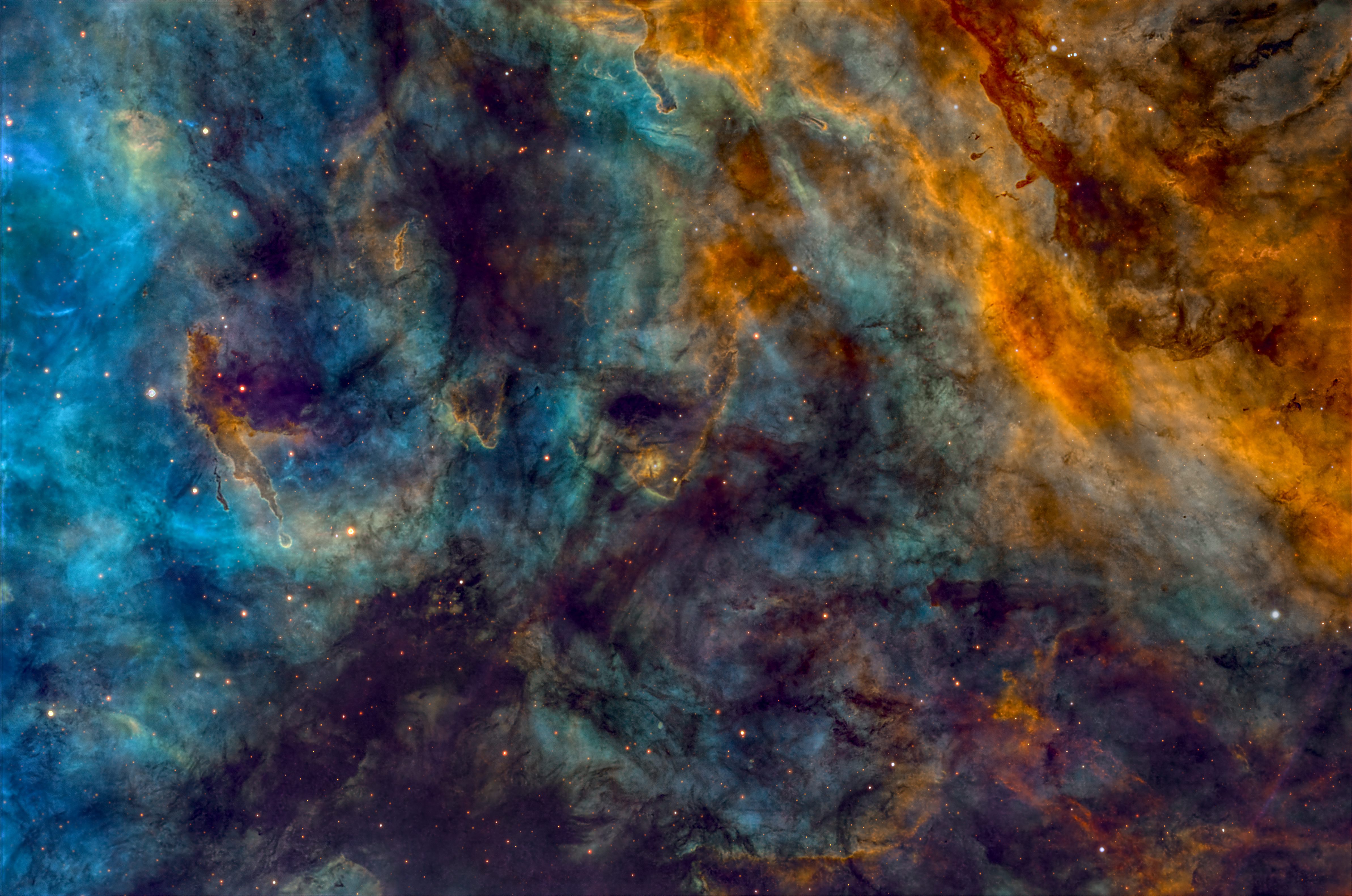 |
 |
| Cederblad 173 (CED 173) also
Sh2-101 - The Tulip Nebula This one is located in the constellation Cygnus(The Swan). I couldn't find any info on this object. Image processed by Ron Yelton, original data from Telescope Live |
CL VDBH 53 Again, no info on this nebula Image processed by Ron Yelton, original data from Telescope Live |
NGC 6888 - The Crescent Nebula
Wide-Field This a cool wide-field view of the area surrounding the Crescent Nebula (in the center). It's a faint object and requires a filter with good contrast. It's in the constellation Cygnus and sits about 5000 light-years away. This image was processed using SHO filter combination. Image processed by Ron Yelton, original data from Telescope Live |
|
Location: IC Astronomy Observatory, Spain Date: May 2022 Mount: Paramount MX+ Telescope: Takahashi FSQ-106ED (SPA-1) (CCD) Camera: FLI PL16083 Exposure: 74 x 5 min for OHS Total: 12 hr 20 min |
Location:
Heaven's Mirror Observatory,
Australia
Date: October 2024 Mount: Paramount MX+ Telescope: FSQ-106ED (AUS-2) Camera: QHY600m @ -25c Exposure: 72 x 5 min each for OHS Total: 6 hrs |
Location: IC Astronomy Observatory, Spain
Date: April 2024 Mount: Paramount MX+ Telescope: Takahashi FSQ-106ED (SPA-1) Camera: QHY600m CMOS @ -25c Exposure: 69 x5 min SHO Total: 5 hrs 45 min |
 |
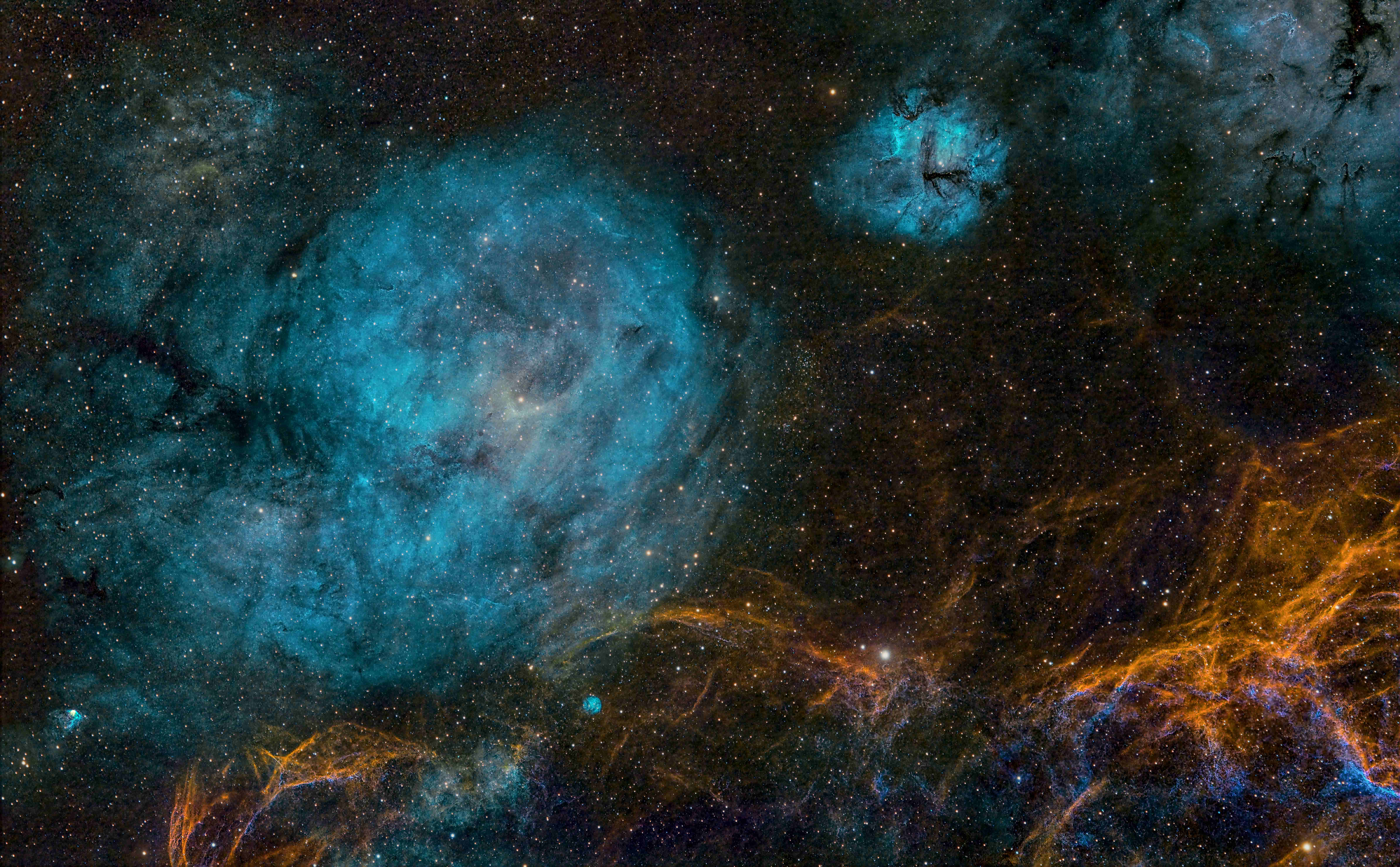 |
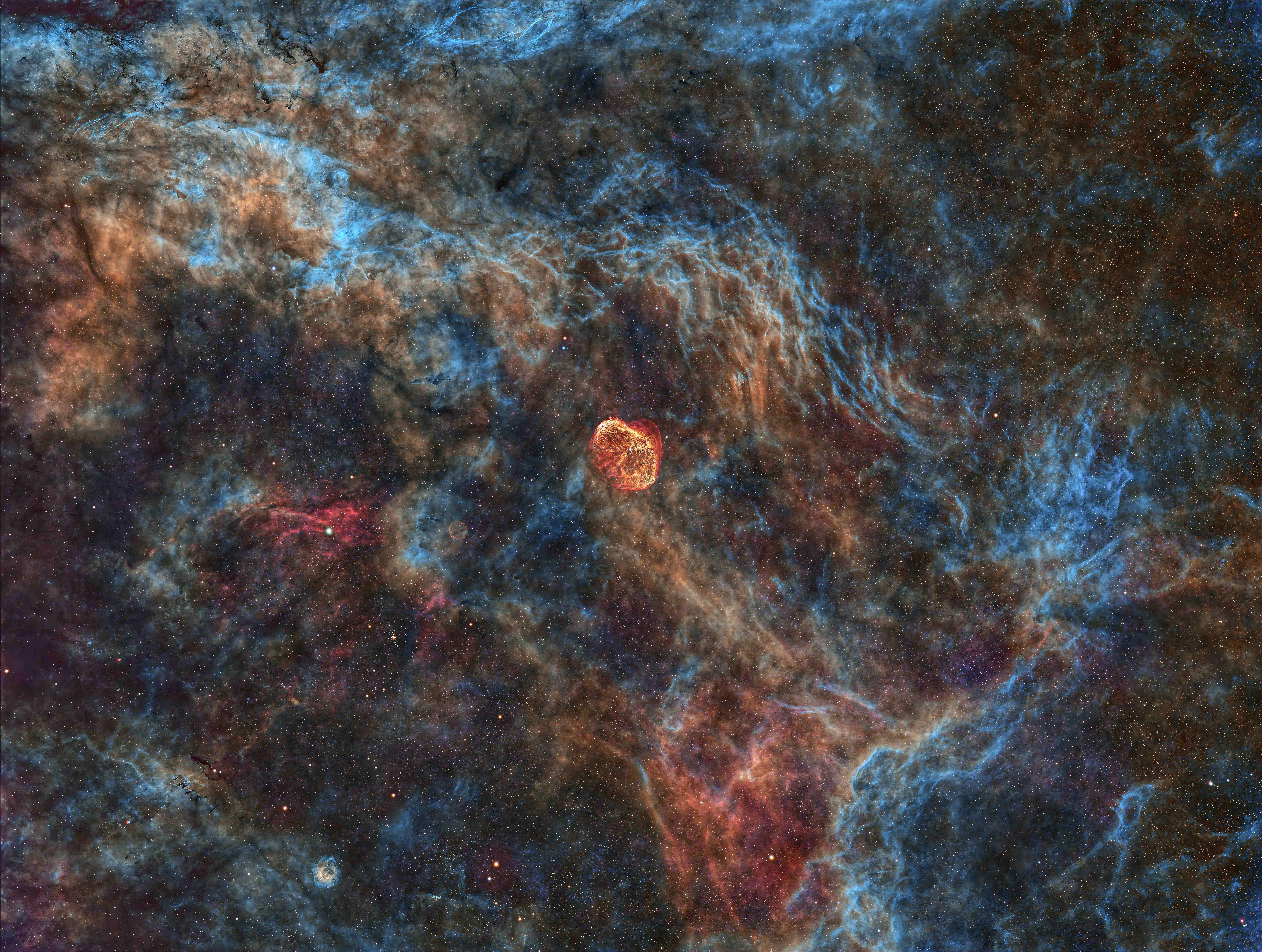 |
|
Cygnus North This is the northern section of the Veil Nebula in the constellation Cygnus (the Swan). It is part of a larger structure known as the Cygnus Loop. It's a supernova remnant whose original star exploded between 10,000 and 20,000 years ago and was roughly 20 times more massive than our Sun. It sits about 2400 light-years away from us. Image processed by Ron Yelton, original data from Telescope Live |
Dust in Chamaeleon This is an image of some interstellar dust in the constellation Chamaeleon, (the Chameleon or Lizard). Image processed by Ron Yelton, original data from Telescope Live |
Sharless 2-190 (Sh2-190) - The
Heart Nebula Also known as the Running Dog Nebula, this is a close-up view of the central region of the interior of the Heart Nebula. This nebula is located in the constellation Cassiopeia and is about 7500 light-years away. The majority of this nebula is made up of ionized oxygen and sulfur, which give the nebula its blue and orange/gold colors. Image processed by Ron Yelton, original data from Telescope Live |
|
Location: El Sauce
Observatory, Chile
Date: September 2023 Mount: Mathis MI-1000/1250 Telescope: Planewave CDK24 (CHI-1) Camera: QHY600m @-25c Exposure: 51 x 5 min for OHS Total: 4 hrs 15 min |
Location:
Heaven's Mirror Observatory, Australia Date: January 11, 2021 Mount: Paramount MX+ Telescope: FSQ-106ED (AUS-2) Camera: FLI PL16083 @ -25c Exposure: 8 x 10 min each for Ha and OIII. Total: 1 hr 20 min. |
Location: IC Astronomy Observatory, Spain Date: January 2022 Mount: Paramount MX+ Telescope:Officina Stellare ProRC 700 (SPA-2) (CCD) Camera: FLI PL16083 Exposure: 62 x 5 min for HSO Total: 5 hr 10 min |
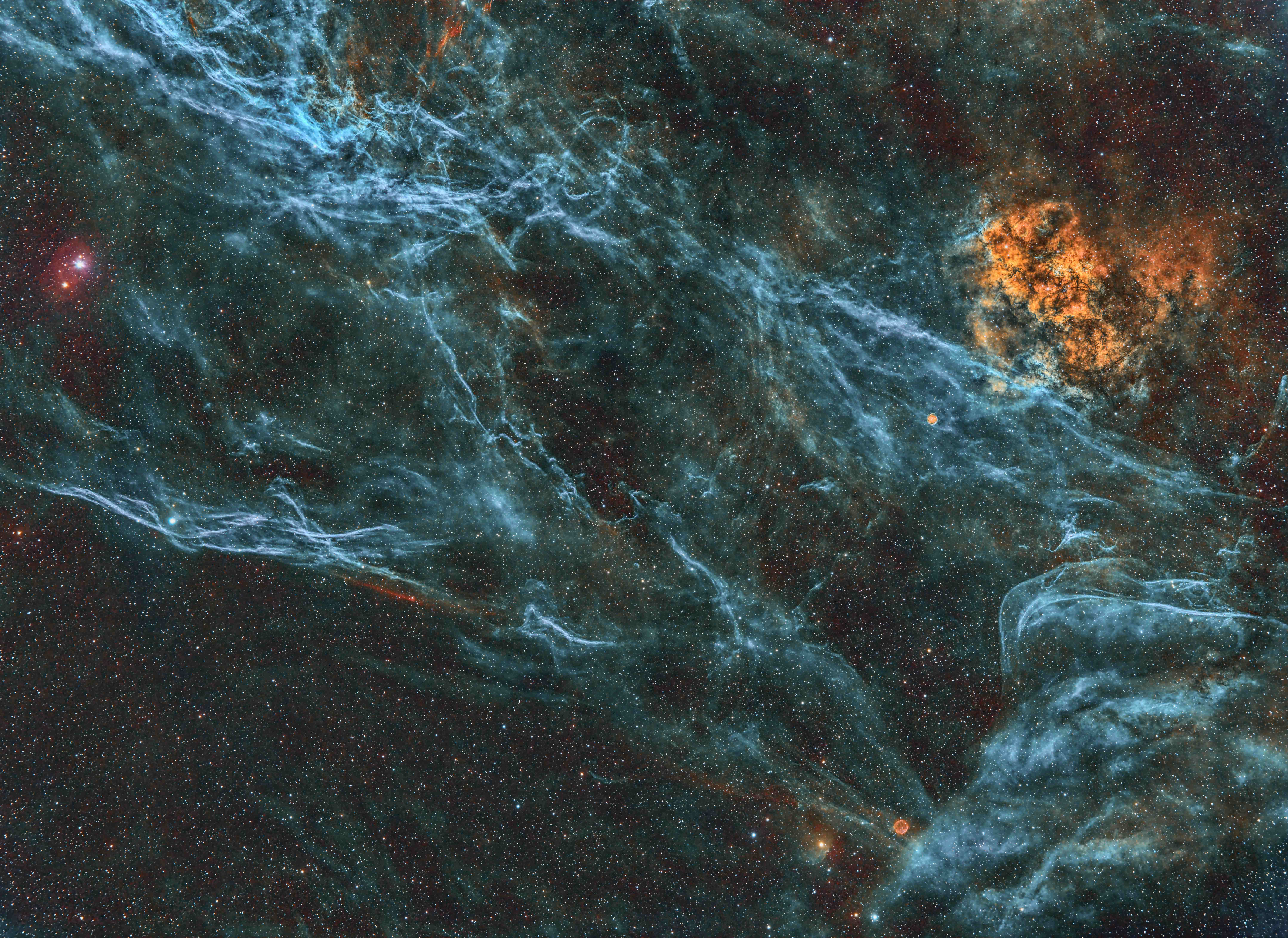 |
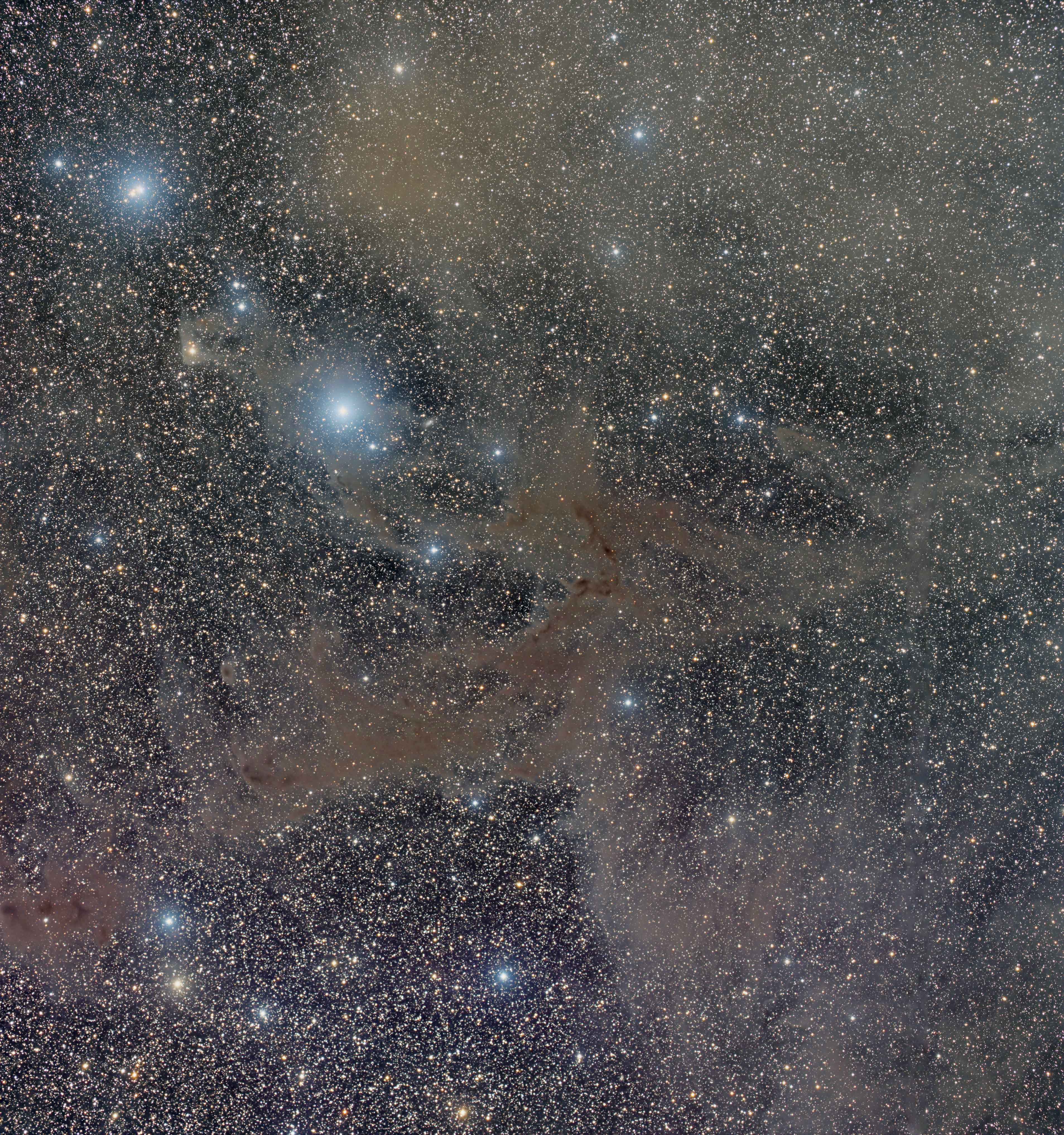 |
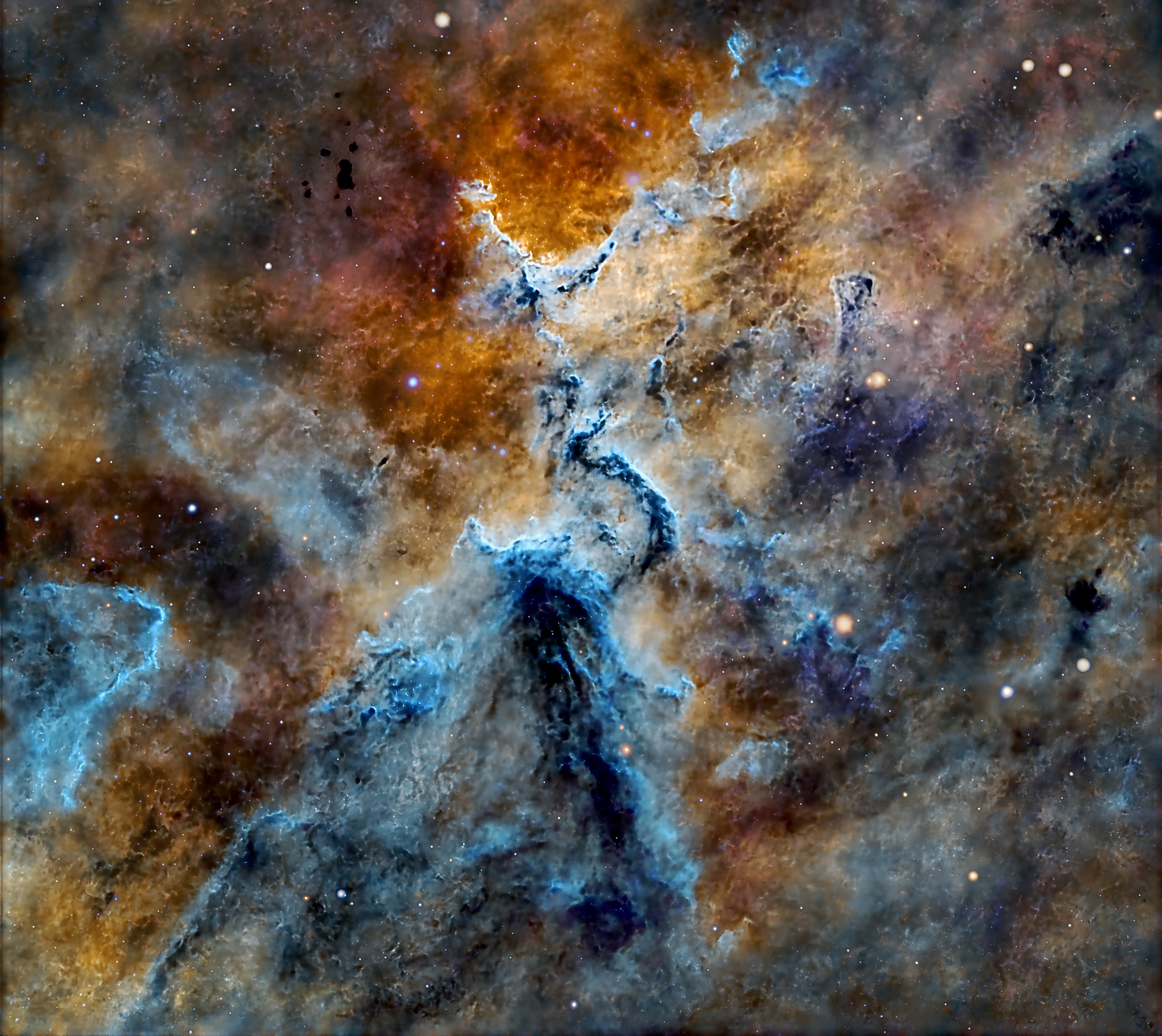 |
| Sharless 2-190 (Sh2-190) - The
Heart Nebula This is the same image as the one above except that I processed it in a completely different way. By changing the color scheme all sorts of different details can be seen. Image processed by Ron Yelton, original data from Telescope Live |
IC 63 or Sh2-185 The central star in this image is Gamma Cassiopeiae. Just up and to the left is the main part of the nebula. This an active star making region, heavy in Hydrgen gas. It was discovered by Max Wolf in 1893. The radiation from this central star is in the process of eroding the nebulosity that surrounds it. The areas that are less dense disappear, leaving the more dense areas which usually hold newly forming stars. This nebula leas about 10,500 light-years away. Image processed by Ron Yelton, original data from Telescope Live |
IC 1396 - The Elephant's Trunk
Nebula Located in the constellation of Cepheus (the King of Ethiopia, husband of Cassiopeia and father Andromeda). In the deep interior of this nebula is the Elephant's trunk, which is a dense globule and an area of star formation. it's about 2400 light-years away. Image processed by Ron Yelton, original data from Telescope Live |
|
Location: IC Astronomy Observatory, Spain Date: January 2022 Mount: Paramount MX+ Telescope:Officina Stellare ProRC 700 (SPA-2) (CCD) Camera: FLI PL16083 Exposure: 62 x 5 min for HSO Total: 5 hr 10 min |
Location: IC Astronomy Observatory, Spain
Date: December 2023 Mount: Paramount MX+ Telescope: Takahashi FSQ-106ED (SPA-1) Camera: QHY600m CMOS @ -25c Exposure: HSO 91 x5 min Total: 7 hrs 35 min |
Location: IC Astronomy
Observatory, Spain Date: August 2022- September 2023 Mount: Paramount MX+ Telescope: FSQ-106EDX4 (SPA-3) Camera: FLI PL16083 Exposure: 98 x 5 min for HLRGB. Total: 14 hr 10 min |
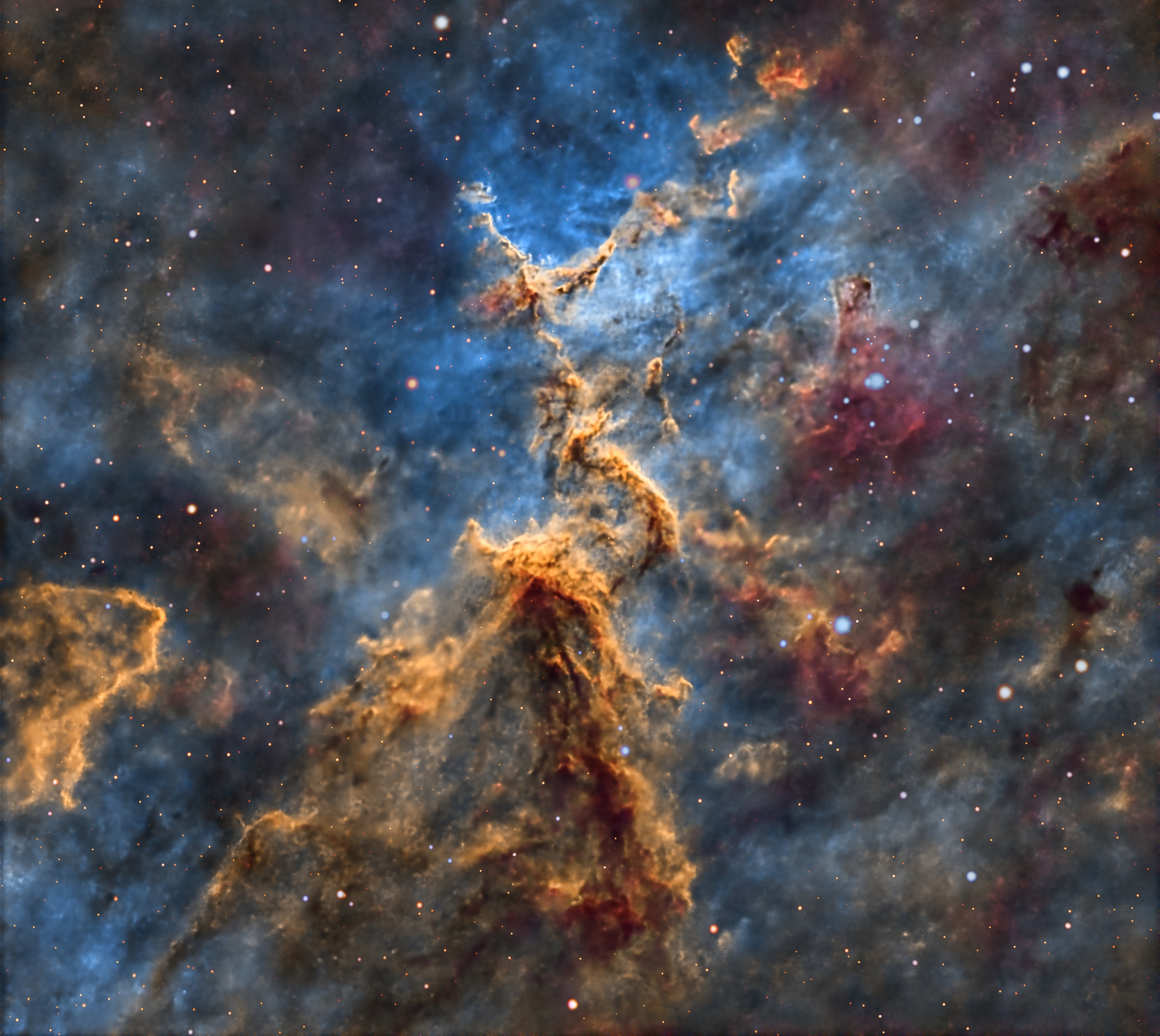 |
 |
 |
| IC 405 - The Flaming Star Nebula This nebula sits in the constellation Auriga (the Charioteer) - just about 1500 light-years away and 5 light-years across. It's both an emission and reflection nebula. This particular image was processed inthe Hubble Palette OHS. The following two images show how different an image can be when the palette is changed around. Oxygen = Red Channel Hydrogen= Green Channel Sulfur = Blue Channel Image processed by Ron Yelton, original data from Telescope Live |
IC 405 - The Flaming Star Nebula This version was processed with in HSO. Hydrogen = Red Channel Sulfur = Green Channel Oxygen = Blue Channel Image processed by Ron Yelton, original data from Telescope Live |
IC 405 - The Flaming Star Nebula This third version was done with the SHO palette. Sulfur = Red Channel Hydrogen = Green Channel Oxygen = Blue Channe Image processed by Ron Yelton, original data from Telescope Livelescope Live |
|
Location: IC Astronomy
Observatory, Spain Date: November 2020 - September 2022 Mount: Paramount MX+ Telescope: Takahashi FSQ-106ED (SPA-1) (CCD) Camera: FLI PL16083 Exposure: 42 x 5 min for OHS Total: 10 hr 30 min |
Location: IC Astronomy
Observatory, Spain Date: November 2020 - September 2022 Mount: Paramount MX+ Telescope: Takahashi FSQ-106ED (SPA-1) (CCD) Camera: FLI PL16083 Exposure: 42 x 5 min for HSO Total: 10 hr 30 min |
Location: IC Astronomy
Observatory, Spain Date: November 2020 - September 2022 Mount: Paramount MX+ Telescope: Takahashi FSQ-106ED (SPA-1) (CCD) Camera: FLI PL16083 Exposure: 42 x 5 min for SHO Total: 10 hr 30 min |
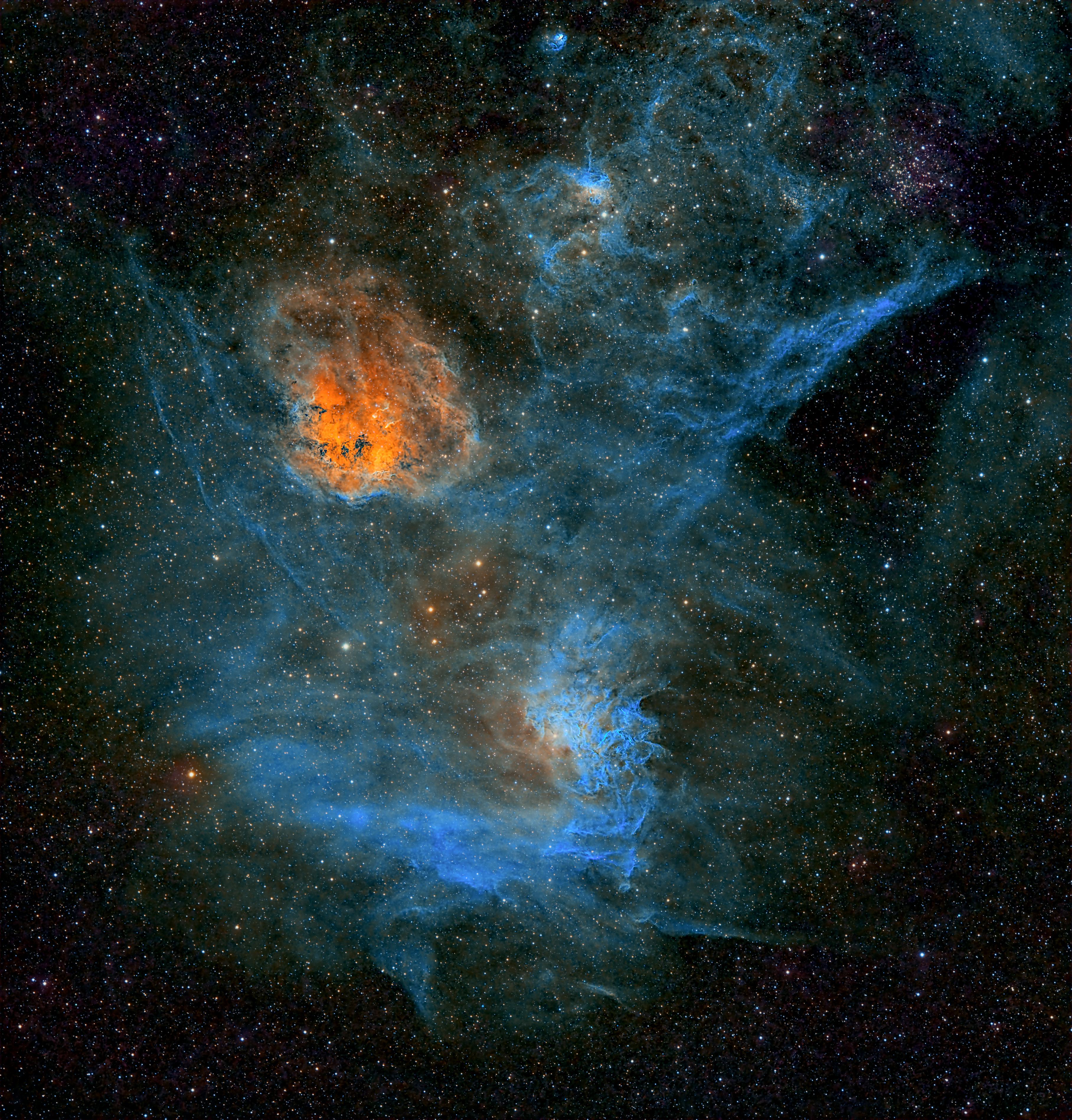 |
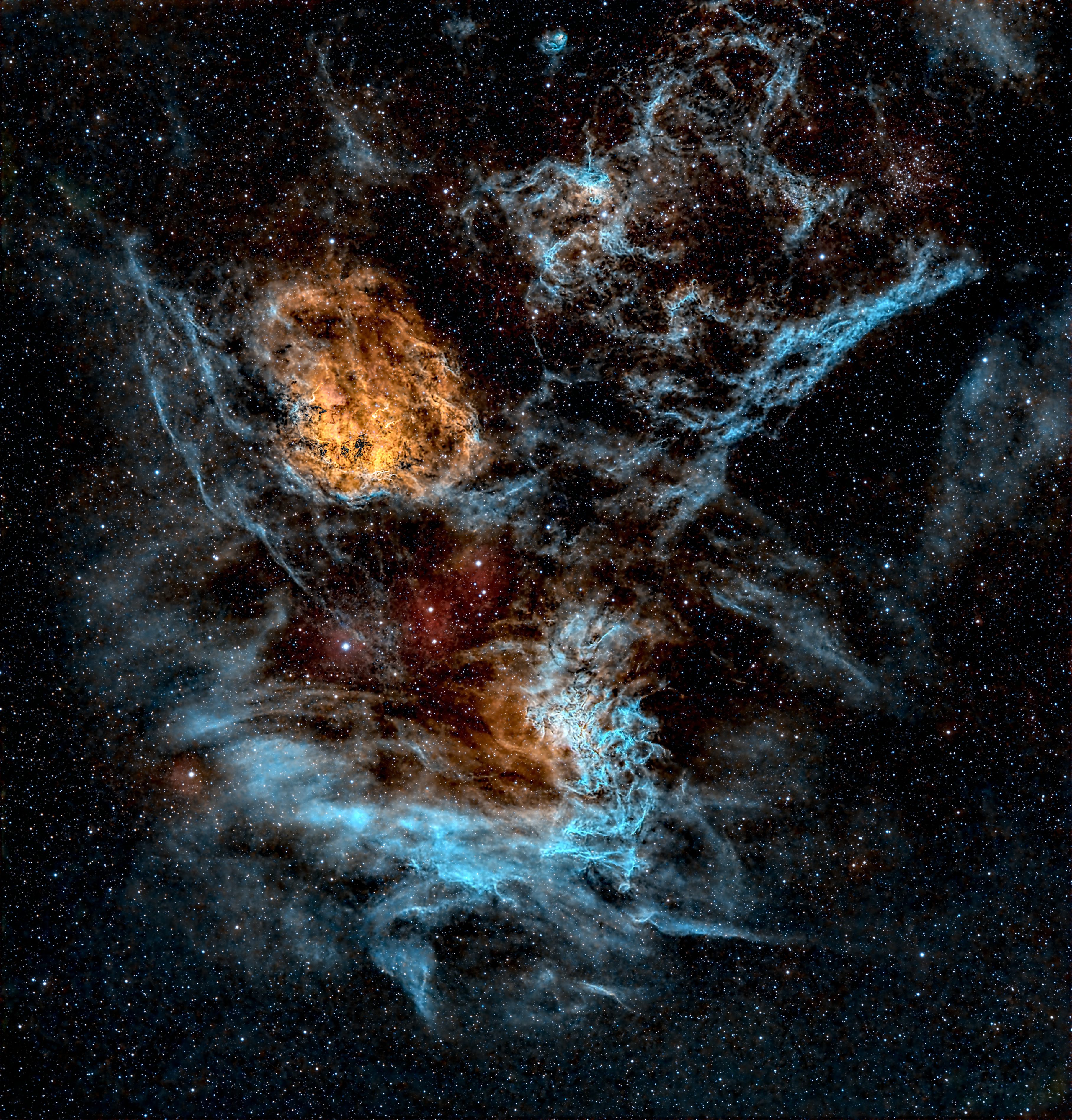 |
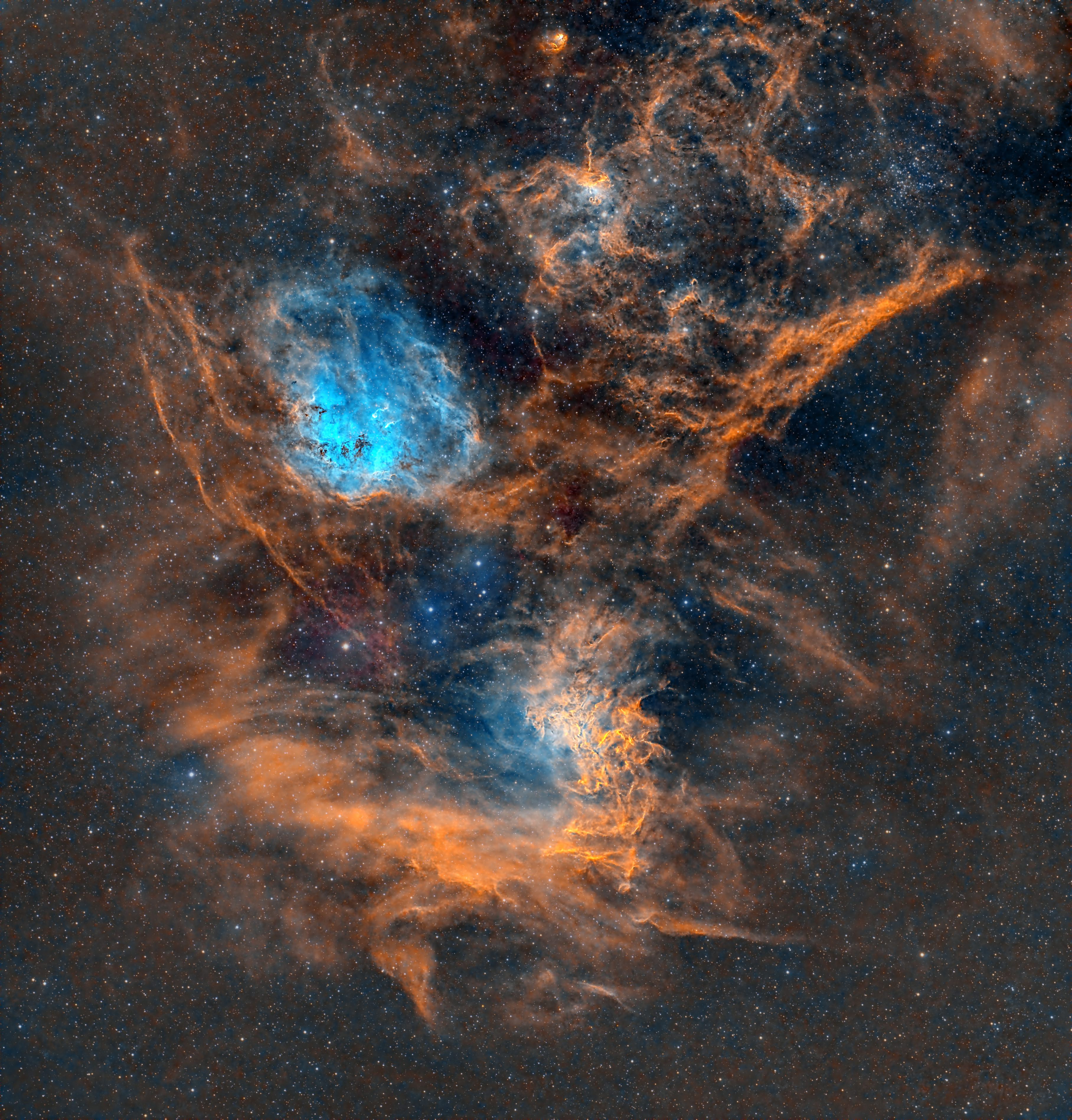
|
| IC 1848 - The Soul Nebula This nebula is commonly known as the Soul Nebula. Located in the northern constellation of Cassiopeia (the Queen mother of Andromeda), this emission nebula contains a number of small open clusters are embedded in its interior. Just to the lower-left of the Soul is the Heart Nebula, another emission nebula. Image processed by Ron Yelton, original data from Telescope Live |
IC 4812 - The Coalsack Nebula The Coalsack Nebula lies about 600 light-yeas from Earth in the Southern constellation of Crux (the Southern Cross). it is one of the rare DSOs that can be seen with the naked eye.It plays an important part in the mythologies of the Australian Aboriginal People, and forms the head of the Emu in the Sky. For the Inca people this nebula was called Yutu, a partridge-like bird in South America. Image processed by Ron Yelton, original data from Telescope Live |
Lupus Dust Panel 3 essedThis one is a dark nebula in the constellation Lupus (the Rabbit).. A dark nebula is simply a cloud of gas or dust that is cold and dense enough to block the light coming from stars or objects behind it. Image processed by Ron Yelton, original data from Telescope LiveImage processed by Ron Yelton, original data from Telescope LiveImage processed by Ron Yelton, original data from Telescope Live |
|
Location: IC Astronomy Observatory, Spain
Date: November 2023 Mount: Paramount MX+ Telescope: Takahashi FSQ-106ED (SPA-1) Camera: QHY600m CMOS @ -25c Exposure: SHO 75 x 5 min Total: 6 hrs 15 min |
Location:
Heaven's Mirror Observatory,
Australia
Date: August 2023 Mount: Paramount MX+ Telescope: FSQ-106ED (AUS-2) Camera: QHY600m @ -25c Exposure: 12 x 5 min each for LRGB. Total: 4hrs |
Location:
Heaven's Mirror Observatory,
Australia
Date: November 2024 2024 Mount: Paramount MX+ Telescope: FSQ-106ED (AUS-2) Camera: QHY600m @ -25c Exposure: 60 x 5 min each for LRGB Total: 5 hrs |
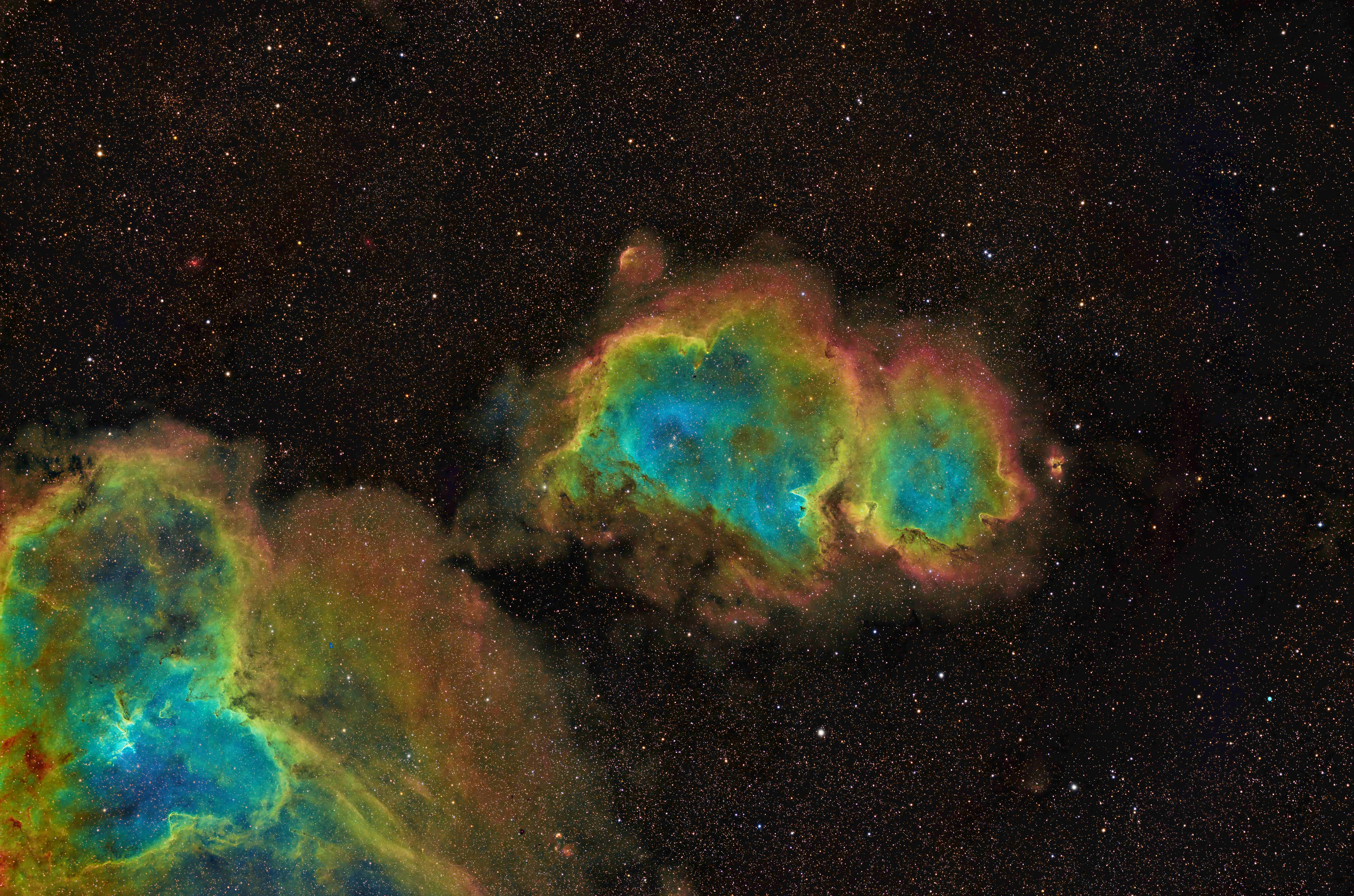 |
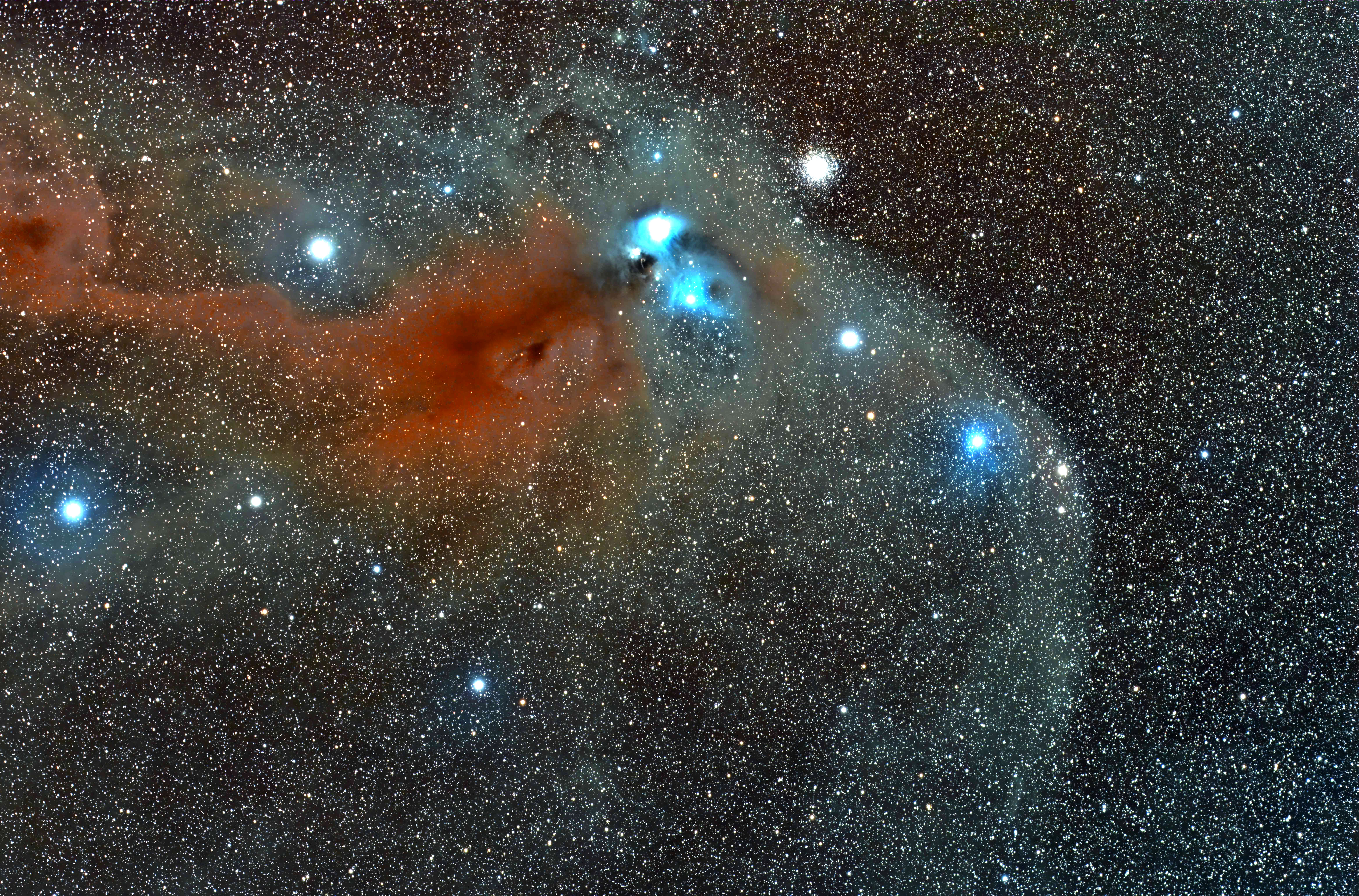 |
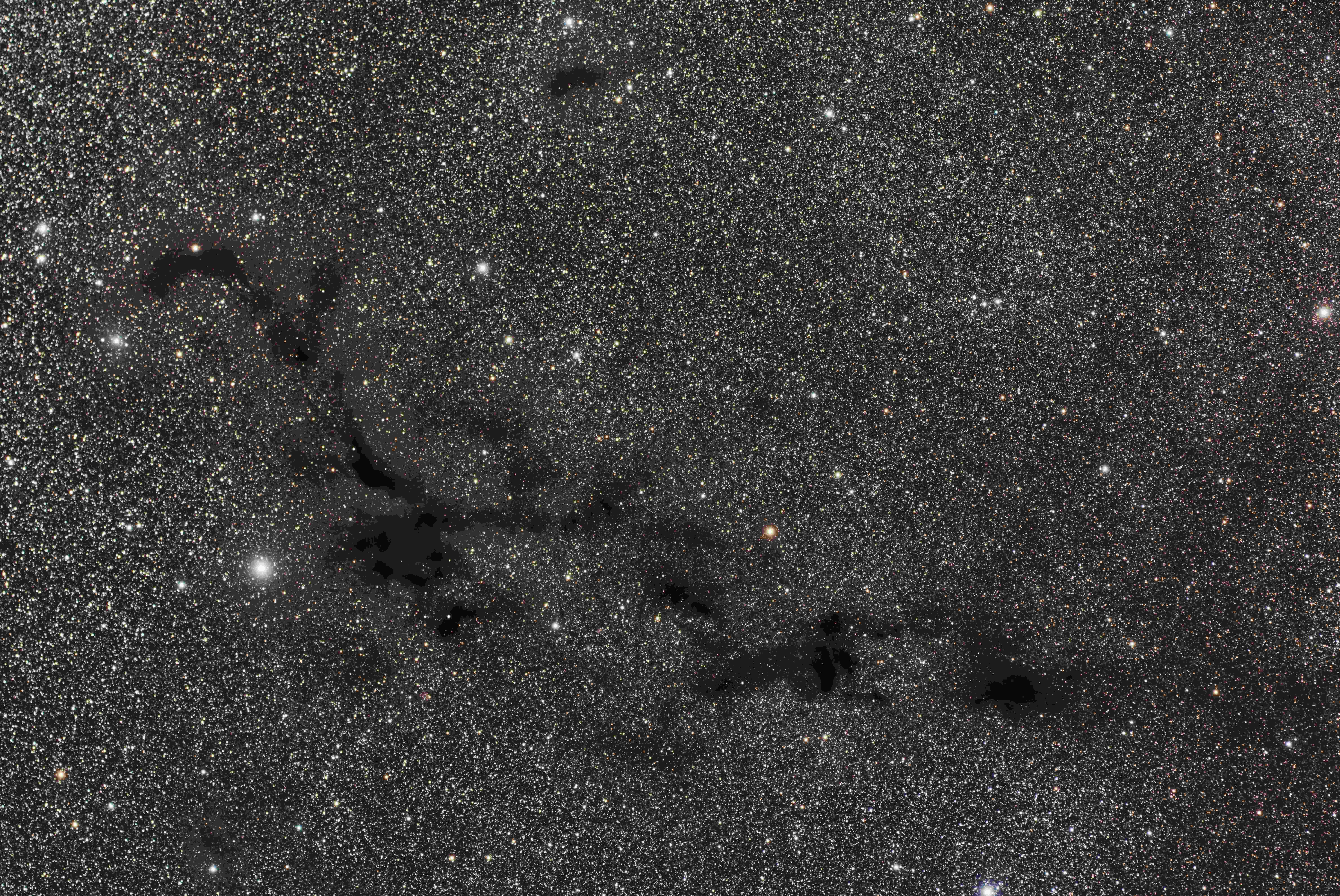
|
| Messier 1 - The Crab nebula lescope LiveThe Crab nebula is a supernova remnant as well as a pulsar wind nebula located in the constellation Taurus (the Bull). It sits about 6500 light-years away. It was given its name because of an early drawing that resembled a crab. Remember, telescopes weren't as good back in the 1600s and 1700s as they are now. At its heart is a pulsar star which is only about 18 miles in diameter and spins at a rate of 30.2 times per second as it emits massive amounts of x-ray and and gamma ray radiation. Image processed by Ron Yelton, original data from Telescope Live |
Messier 6 Messier 6 is actually the open cluster at the center of the image. I include it here because of the nebula right next to it - IC 4605. It is a reflection nebula located in the constellation Scorpius, and illuminated by its central star HD 148605. Image processed by Ron Yelton, original data from Telescope Live |
Messier 6 This is a close-up view of the object to the left, taken with a larger telescope. Image processed by Ron Yelton, original data from Telescope Live |
|
Location: IC Astronomy Observatory, Spain
Date: October 2023 Mount: Paramount MX+ Telescope:Officina Stellare ProRC 700 (SPA-2) Camera: QHY600m CMOS @ -25c Exposure: 74 x 5 min LRGB Total: 6 hrs 10 min |
Location: Heaven's
Mirror Observatory, Australia Date: July 2021 Mount: Paramount MX+ Telescope: FSQ-106ED (AUS-2) Camera: FLI PL16083 @ -25c Exposure: 72 x 10 min each for OHS Total: 12 hrs |
Location: El Sauce
Observatory, Chile
Date: May 2023 Mount: Mathis MI-1000/1250 Telescope: Planewave CDK24 (CHI-1) Camera: QHY600m @-25c Exposure: 72 x 5 min for OHS Total: 6 hrs |
 |
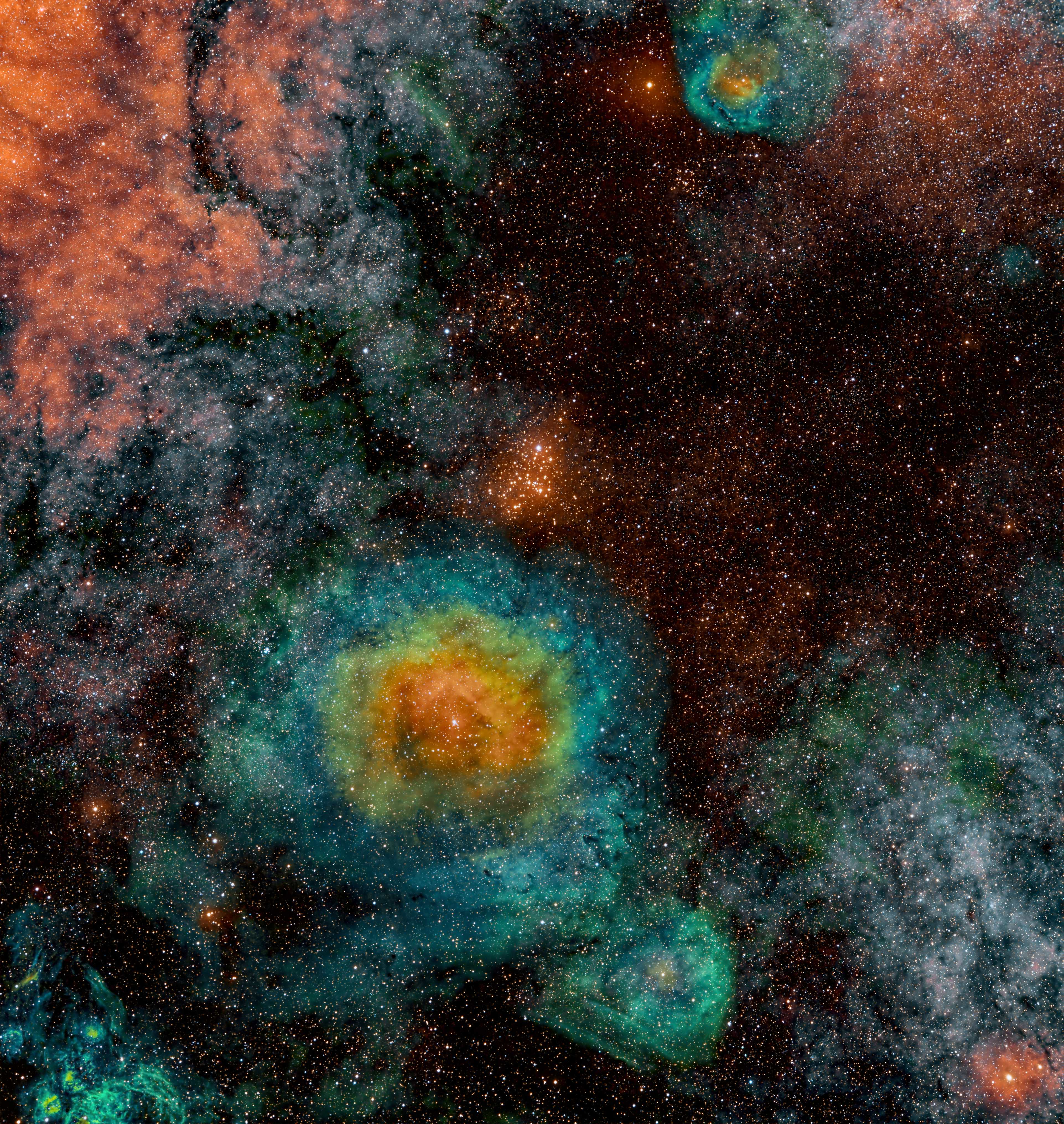 |
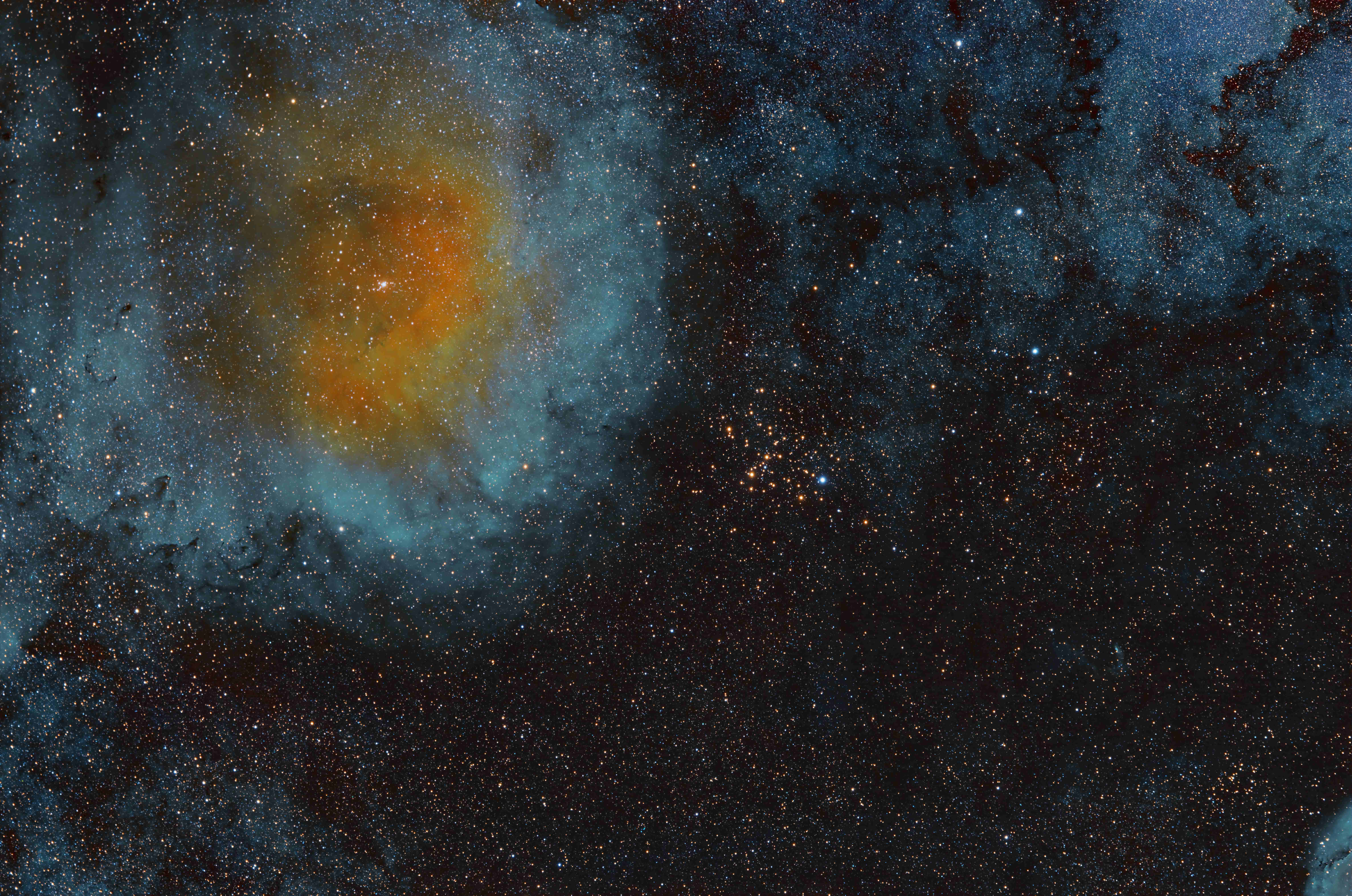
|
|
Messier 42 Wide-Field A wide-field view of the larger molecular cloud around Messier 42 - the Great Orion Nebula, which is the orange area to the right side. The Orion Nebula is a fascinating object.It sits about 1344 light-years away and has a mass of about 2000 times that of the Sun. Its also about 25 light-years across at its maximum. it is the largest star formation region closest to Earth. At its center is an area known as the Trapezium, where a number of hot, new stars can be seen. This is one of the most studied and photographed object in our night sky. Image processed by Ron Yelton, original data from Telescope Live |
Messier 42 Wide-Field
-Starless leThis is the same image as the one to the left except that all of the stars have bee removed. I like this version, as it had kind of a surreal look and feel to it. Image processed by Ron Yelton, original data from Telescope Live |
Sh2-274 - The Medusa Nebula This object is a planetary nebula, and was discovered in 1975 by UCLA astronomer George Abell.in 1955. Abell thought that it was an old planetary nebula. then, in 1975 researches found that it was indeed a PN. The nebula is very large due to its expansion over a very long period which makes its surface brightness very low. That means that you'd need to use a camera with longer exposure times to see it. It is about 1500 light-years away in the constellation Gemini. Image processed by Ron Yelton, original data from Telescope Live |
|
Location: IC Astronomy
Observatory, Spain Date: November 2023 Mount: Paramount MX+ Telescope: FSQ-106EDX4 (SPA-3) Camera: FLI PL16083 Exposure: 127 x 5 min for OHS Total: 10 hr 5 min |
Location: IC Astronomy
Observatory, Spain Date: November 2023 Mount: Paramount MX+ Telescope: FSQ-106EDX4 (SPA-3) Camera: FLI PL16083 Exposure: 127 x 5 min for OHS Total: 10 hr 5 min |
Location: El Sauce
Observatory, Chile
Date: November 2024 Mount: Mathis MI-1000/1250 Telescope: Planewave CDK24 (CHI-1) Camera: QHY600m @-25c Exposure: 18 x 5 min for OHS. Total: 5 hrs 15 min |
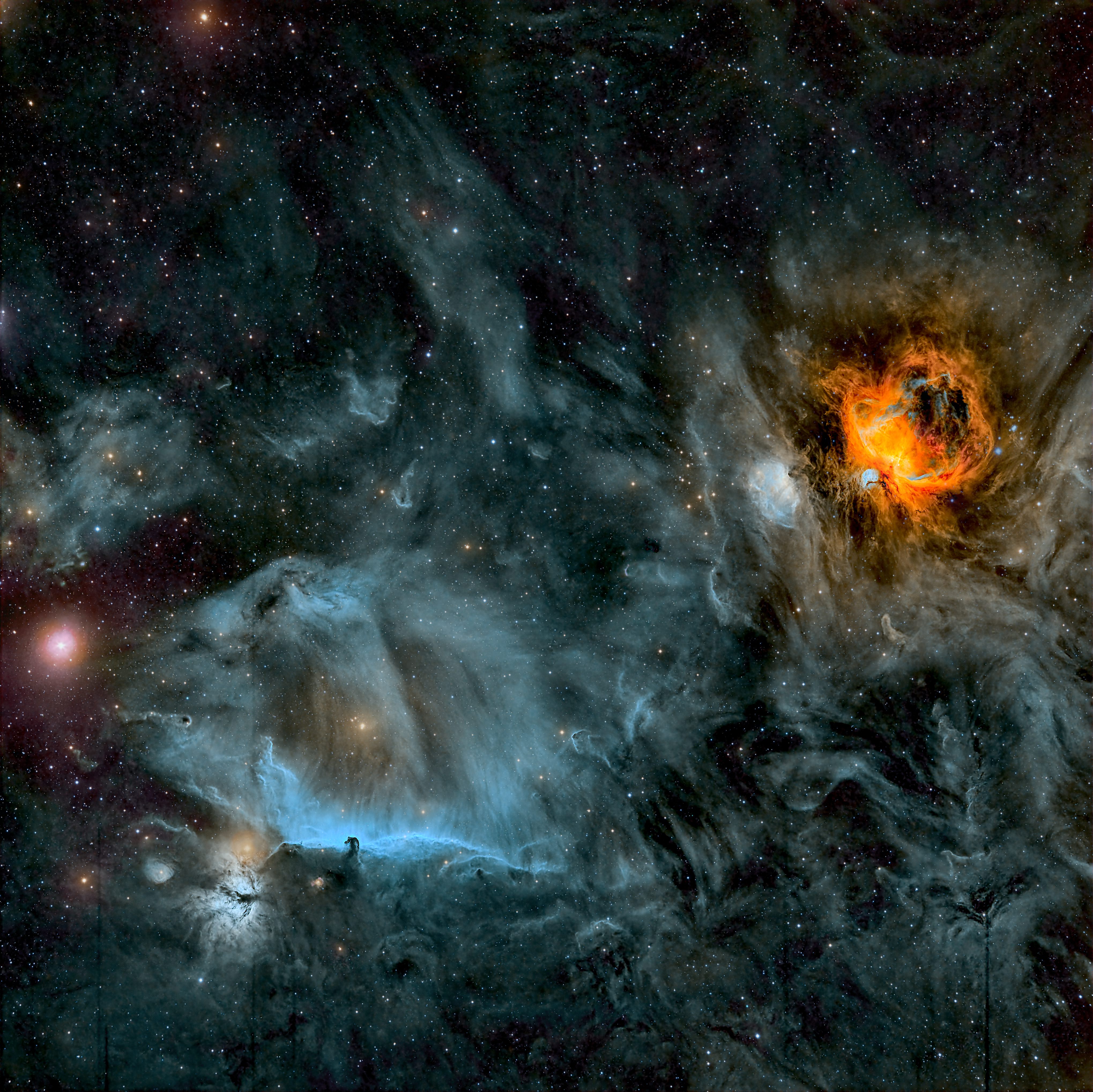 |
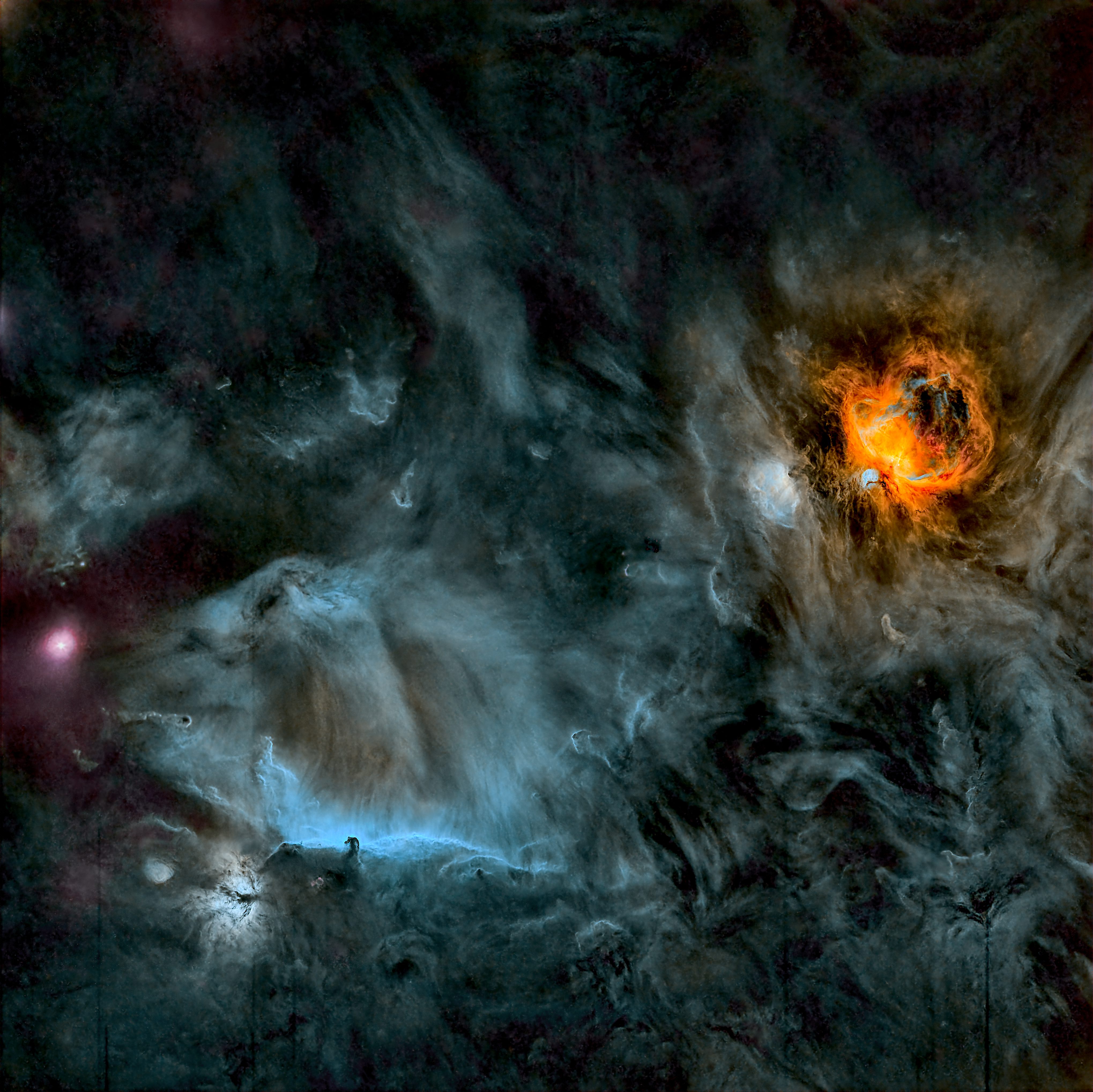 |
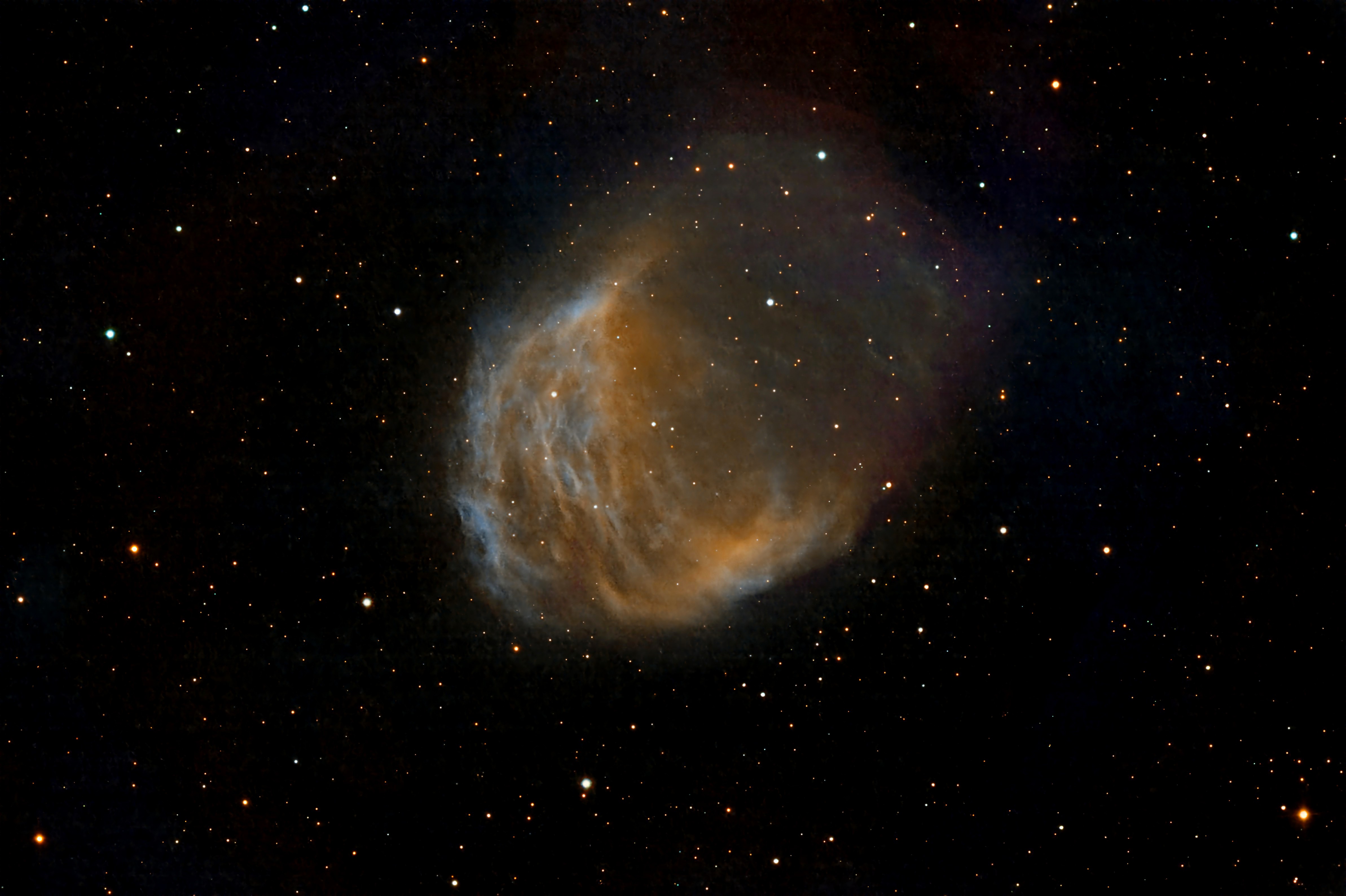
|
|
Sh2-1
Known as Sharpless-1, this is both a reflection and emission nebula as well a a diffuse nebula in Scorpius. It sits about 650 light-years away from Earth. This image was process using visible light filters (RGB) as wellas a hydrogen filter which brings out the deep red hydrogen region on the left side. Image processed by Ron Yelton, original data from Telescope Live |
NGC 2014 This nebula, located in the Large Magellanic Cloud (LMC), is a red emission nebula which sits at an impressive distance if 163,000 light-years away. Image processed by Ron Yelton, original data from Telescope Live |
NGC 6188
(The Rim Nebula) and NGC 6165 Also known as the Dragons of Ara, the Rim Nebula is just a small part of a much larger molecular cloud. This part of the planetary nebula contains an emission nebula that includes some dark nebula as well. It lies about 4000 light-years away from us and is about 300 light-years in diameter. The small blue nebula in the upper right has two sections - an outer bubble and an inner bubble - probably from and earlier mass ejection from its central star, a kind that lives very hot and very short. Since the larger nebula is often referred to at the Fighting Dragons of Ara, this smaller nebula is called The Dragon's Egg. Image processed by Ron Yelton, original data from Telescope Live |
|
Location:
Heaven's Mirror Observatory,
Australia
Date: October 2024 Mount: Paramount MX+ Telescope: FSQ-106ED (AUS-2) Camera: QHY600m @ -25c Exposure: 60 x 5 min each for HLRGB Total: 5 hrs |
Location: El
Sauce Observatory, Chile Date: October 25, 2020 Mount: Mathis MI-1000 Telescope: Planewave CDK24 f/6.6 (CHI-1) Camera: FLI PL9000 @ -25c Exposure: 8 x 10 min each for LRGBHa. Total: 1 hr 20 min. |
Location:
Heaven's Mirror Observatory,
Australia
Date: May 2023 Mount: Paramount MX+ Telescope: FSQ-106ED (AUS-2) Camera: QHY600m @-30c CMOS Exposure: 20 x 5min each for HSO. Total: 1 hr 40 min |
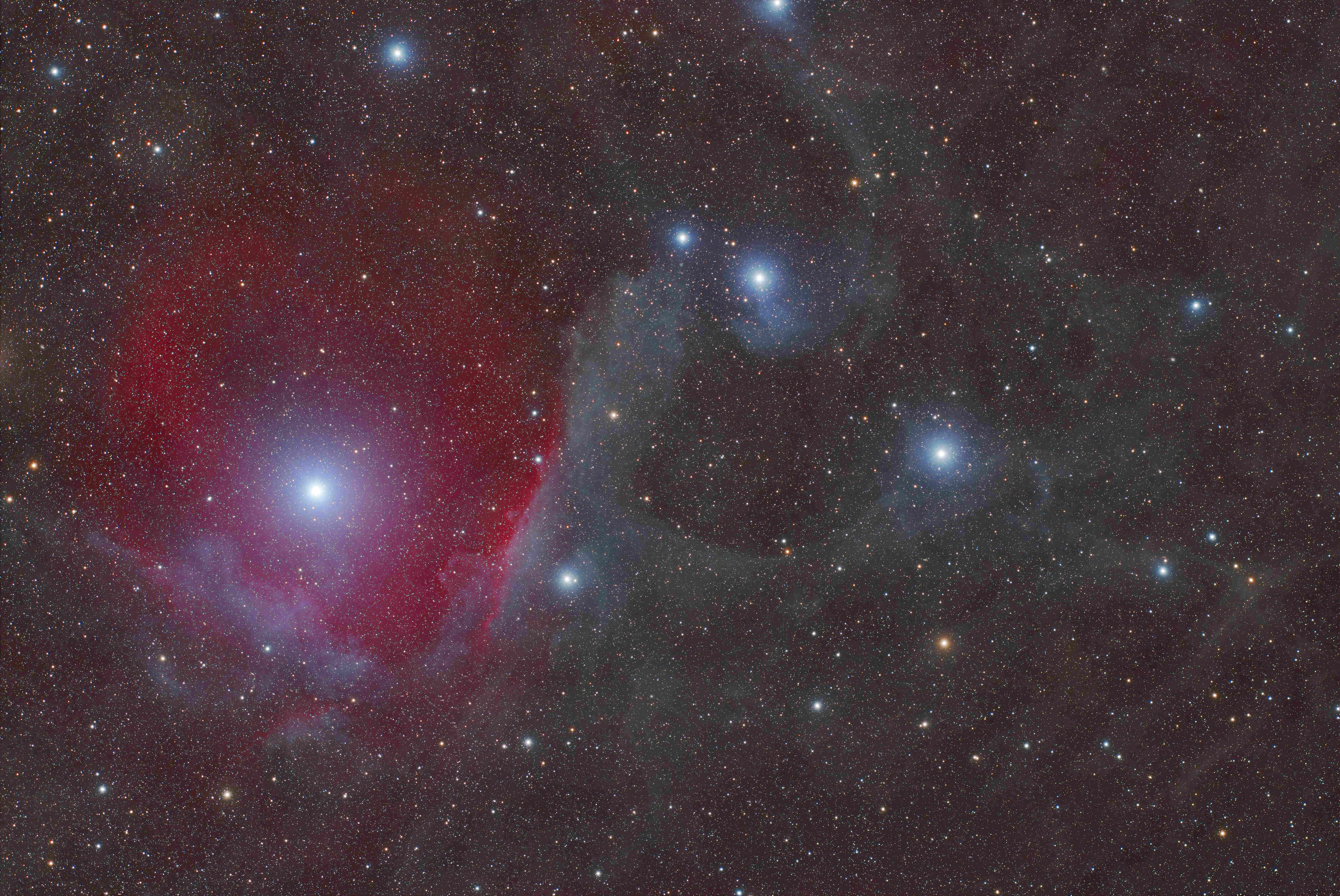 |
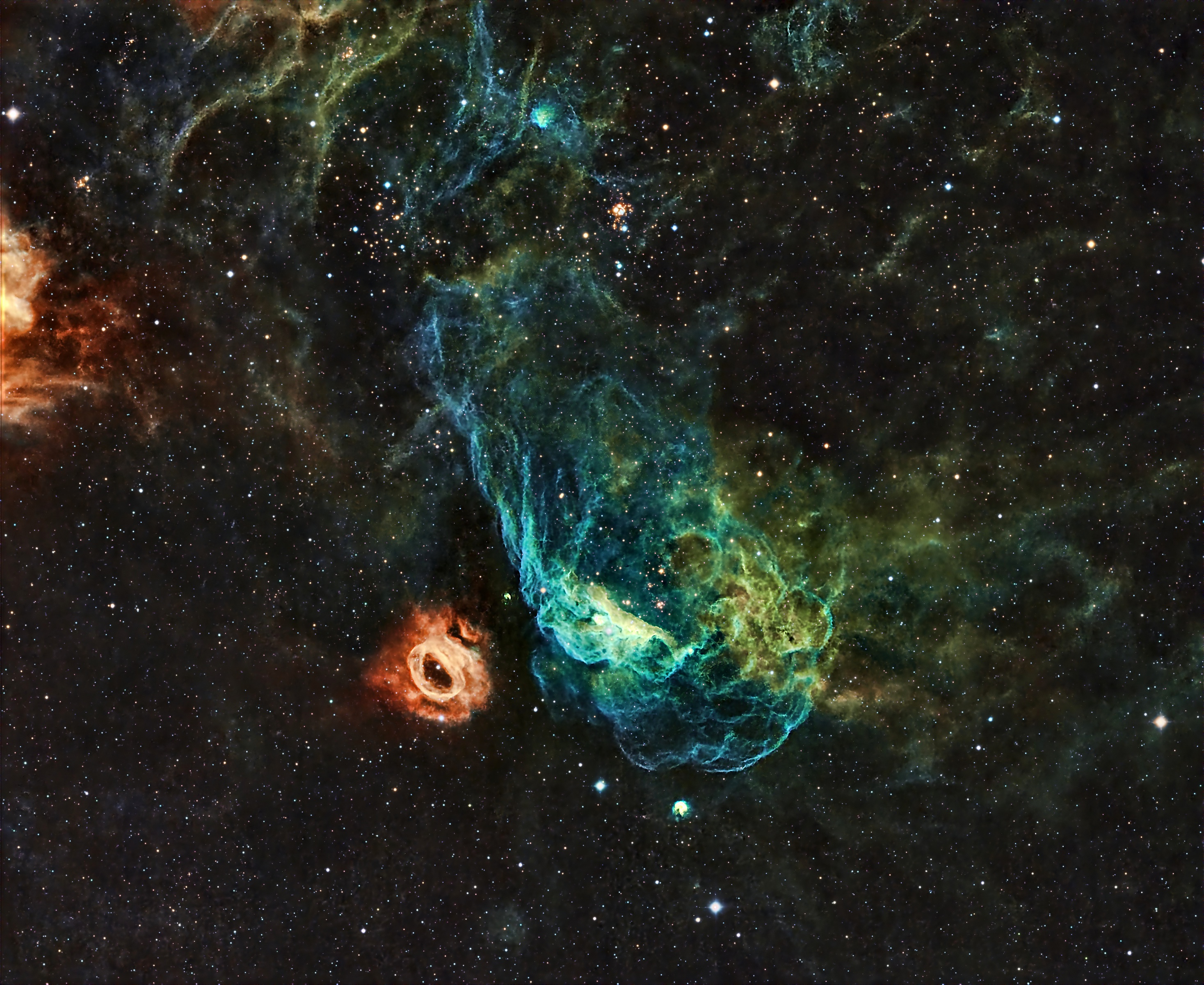 |
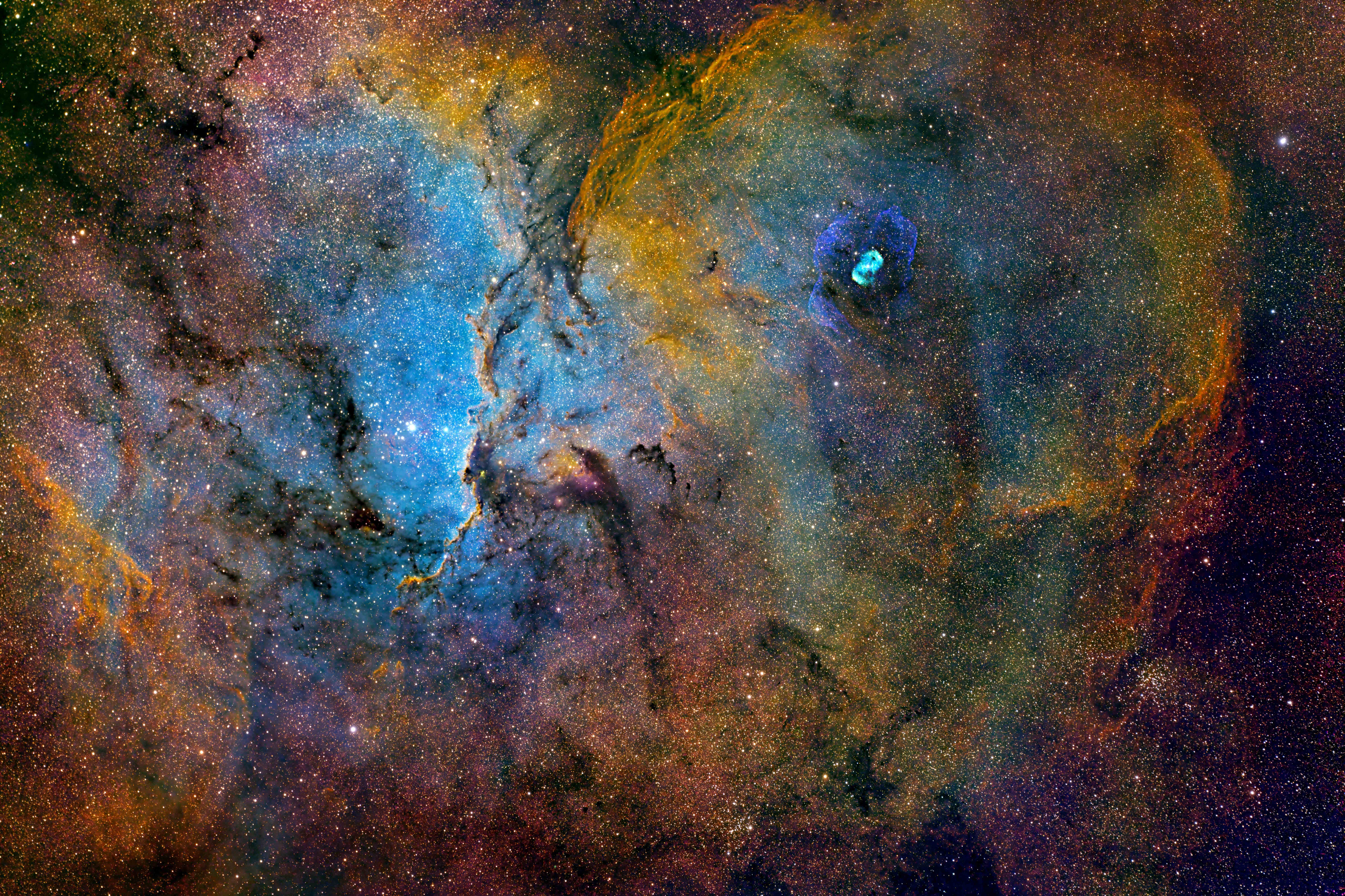
|
|
Caldwell 49 - The Rosette
Nebula This object, located in Monoceros ( the Unicorn), is part of a much larger molecular cloud complex. It sits about 5000 light-years away and is about 130 light-years in diameter. Some say that it resembles a human skull and is sometimes called the Skull Nebula. It has, at its center an open cluster. the radiation from these hot, young stars excites the gas nearby and heats it until it begins to glow - making this an emission nebula. there are around 2500 hot, new stars. Most of the active star making is in the lower central region. For this version I removed the stars and applied a portrait tool in Pixinsight to give it this unique look. Image processed by Ron Yelton, original data from Telescope Live |
|
|
Location: IC Astronomy Observatory, Spain
Date: October 2023 Mount: Paramount MX+ Telescope: Takahashi FSQ-106ED (SPA-1) Camera: QHY600m CMOS @ -25c Exposure: 93 x5 min OHS Total: 7 hrs 45 min |
|
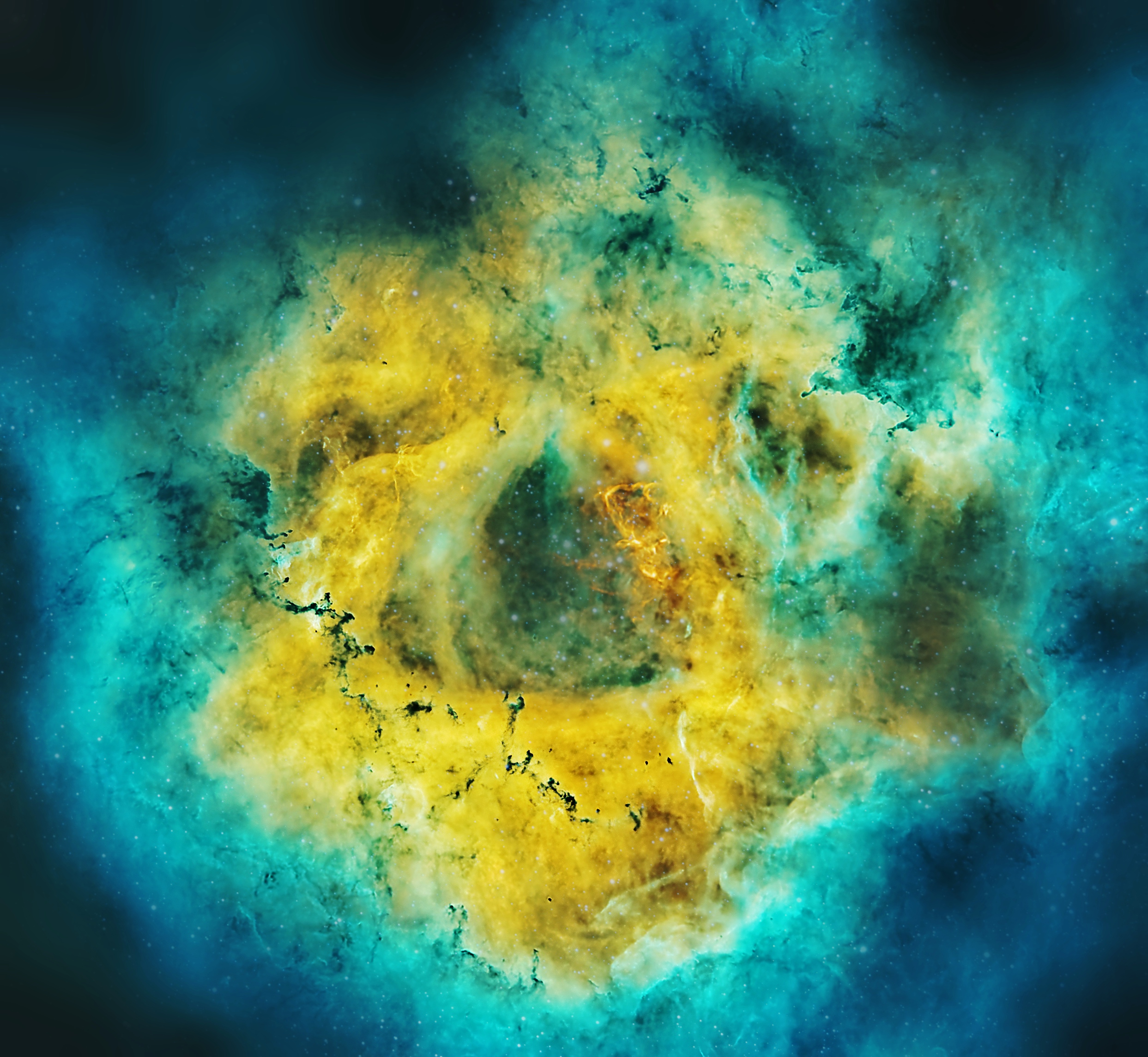 |
Except as noted all images Copyright © by Ron Yelton and may not be used without permission.